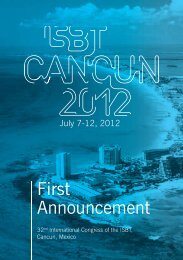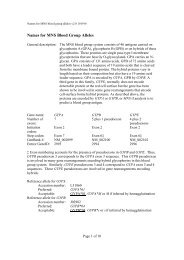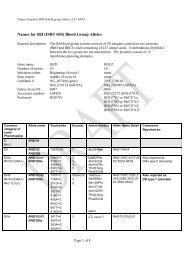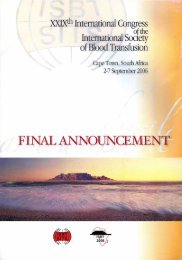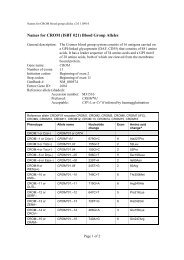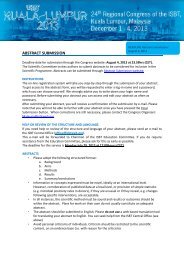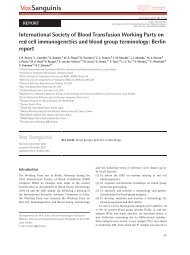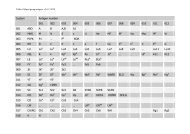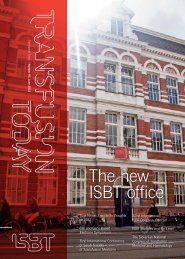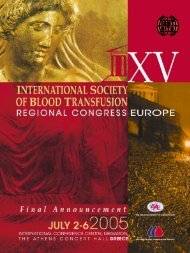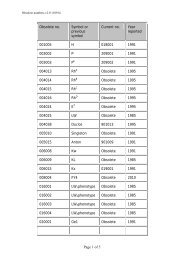The role of the international community in ensuring a safe and ...
The role of the international community in ensuring a safe and ...
The role of the international community in ensuring a safe and ...
- No tags were found...
You also want an ePaper? Increase the reach of your titles
YUMPU automatically turns print PDFs into web optimized ePapers that Google loves.
Transfusion Today | Number 82, March 2010Haïti<strong>The</strong> <strong>role</strong> <strong>of</strong> <strong>the</strong> <strong><strong>in</strong>ternational</strong><strong>community</strong> <strong>in</strong> ensur<strong>in</strong>g a <strong>safe</strong><strong>and</strong> available blood supplyRecomb<strong>in</strong>ant bloodgroup prote<strong>in</strong>sBlood group genotyp<strong>in</strong>gBlood Group Term<strong>in</strong>ology:history <strong>and</strong> purposeABO <strong>and</strong> malaria
Contents Whats on at ISBT244 15 Judith ChapmanEditorialcobas s 201 system<strong>The</strong> first multi-dye NAT screen<strong>in</strong>g systemfor donated bloodcobas s 201 systemRoche’s cobas s 201 system is a reliable, operator-friendlyplatform with fast <strong>and</strong> easy daily start-up <strong>and</strong> m<strong>in</strong>imalma<strong>in</strong>tenance.Tests that are currently <strong>in</strong> development will take fulladvantage <strong>of</strong> <strong>the</strong> 4-channel, multi-dye detection technology<strong>of</strong> <strong>the</strong> cobas s 201 system by <strong>of</strong>fer<strong>in</strong>g real-time virusdiscrim<strong>in</strong>ation <strong>in</strong> a s<strong>in</strong>gle test.ROCHE, COBAS, COBAS S, LIFE NEEDS ANSWERS,<strong>and</strong> TAQSCREEN, are trademarks <strong>of</strong> Roche.©2010 Roche Molecular Systems, Inc. All rights reserved.http://molecular.roche.comcobas ® TaqScreen MPX Test<strong>The</strong> current cobas ® TaqScreen MPX Test simultaneouslydetects all known genotypes <strong>and</strong> subtypes <strong>of</strong> HIV-1Groups M <strong>and</strong> O, HIV-2, HCV <strong>and</strong> HBV, mak<strong>in</strong>g it <strong>the</strong>most comprehensive NAT test on <strong>the</strong> market.This multiplex, CE Mark certified <strong>and</strong> FDA-approved testis currently used by over 175 blood banks worldwide.4152431In focusBlood Group Term<strong>in</strong>ology; ISBT Workshops; A new term<strong>in</strong>ology forblood group alleles; Recomb<strong>in</strong>ant blood group prote<strong>in</strong>s; Blood groupgenotyp<strong>in</strong>g; ABO <strong>and</strong> malariaAbout ISBTFrom <strong>the</strong> president; Sixth Congress <strong>of</strong> <strong>the</strong> ISBT; Into <strong>the</strong> ModernEra; From <strong>the</strong> Secretary-General; From ISBT Central OfficeRegional newsHaïti earthquake 2010; Blood Collection Campaigns; <strong>in</strong> Afghanist<strong>and</strong>ur<strong>in</strong>g Ashura; ISBT- ATMC7; Western Pacific ActivitiesUpcom<strong>in</strong>g Berl<strong>in</strong>XXXI st International Congress <strong>of</strong> <strong>the</strong> ISBT; Upcom<strong>in</strong>g eventsPresident Erhard Seifried Secretary General Paul Strengers Executive Director Judith ChapmanDesign Tomorrow Design Photography Transfusion Today Advertis<strong>in</strong>g Sophie Hamburger,central<strong>of</strong>fice@isbt-web.orgStatements <strong>and</strong> op<strong>in</strong>ions expressed <strong>in</strong> Transfusion Today are those <strong>of</strong> <strong>the</strong> <strong>in</strong>dividual contributors <strong>and</strong>not that <strong>of</strong> ISBT. Reproduction <strong>in</strong> whole or part requires permission by <strong>the</strong> publisher. ISBT membersneed not obta<strong>in</strong> permission if proper credit is given.Send all correspondence to ISBT - J. van Goyenkade 11, 1075 HP, Amsterdam, <strong>The</strong> Ne<strong>the</strong>rl<strong>and</strong>s.T +31 20 5709 636, F +31 20 6737 306, transfusiontoday@isbt-web.org.Welcome to <strong>the</strong> first issue <strong>of</strong> TransfusionToday <strong>in</strong> 2010. We hope that you like<strong>the</strong> new look <strong>and</strong> format <strong>of</strong> our ISBTquarterly bullet<strong>in</strong>. Please note that <strong>the</strong>former Regional Supplement has been<strong>in</strong>corporated <strong>in</strong>to <strong>the</strong> ma<strong>in</strong> body <strong>of</strong>Transfusion Today.<strong>The</strong> focus <strong>of</strong> this edition is Blood Groupswith <strong>the</strong> contributors be<strong>in</strong>g members<strong>of</strong> <strong>the</strong> Work<strong>in</strong>g Party on Red Cell Immunogenetics<strong>and</strong> Blood Group Term<strong>in</strong>ology.Developments are occurr<strong>in</strong>g with<strong>in</strong> bloodgroup term<strong>in</strong>ology, <strong>in</strong> blood group<strong>in</strong>gpractice <strong>and</strong> <strong>in</strong> our knowledge <strong>of</strong> <strong>the</strong>relationship between blood groups <strong>and</strong>diseases such as malaria. This is one<strong>of</strong> <strong>the</strong> reasons why we thought a focuson blood groups was a good topic tostart our new look Transfusion Today.We thank Ge<strong>of</strong>f Daniels, <strong>the</strong> Work<strong>in</strong>gParty chairperson for putt<strong>in</strong>g <strong>the</strong> sectiontoge<strong>the</strong>r, choos<strong>in</strong>g <strong>the</strong> topics <strong>and</strong> writers<strong>and</strong> mak<strong>in</strong>g sure all <strong>the</strong> articles werereceived on time.<strong>The</strong>re is an important article ondevelopments that are currently tak<strong>in</strong>gplace with<strong>in</strong> ISBT related to our image,read more under ‘Into <strong>the</strong> modern era.’You can also read more about <strong>the</strong>programme for our XXXl st InternationalCongress <strong>in</strong> Berl<strong>in</strong> <strong>and</strong> <strong>the</strong> first <strong>of</strong> aseries <strong>of</strong> four articles on congressesremembered by our historian.If you have any comments on TransfusionToday we would like to hear from you.We would also like feedback about <strong>the</strong>subjects <strong>and</strong> articles that you would likeus to cover.Transfusion Today | Number 82, March 20103
In Focus ISBT Work<strong>in</strong>g Party on Cell Immunogenetics <strong>and</strong> Blood Group Term<strong>in</strong>ologyBlood GroupGe<strong>of</strong>f DanielsChair, ISBT Work<strong>in</strong>g Party on Cell Immunogenetics<strong>and</strong> Blood Group Term<strong>in</strong>ologyTerm<strong>in</strong>ology:history <strong>and</strong> purpose‘What’s <strong>in</strong> a name? That which we call a rose, by any o<strong>the</strong>r namewould smell as sweet.’ Of course, Juliet was correct. A name isonly a label, but absolutely imperative for effective communication,<strong>and</strong> <strong>in</strong> blood transfusion effective communication is vital.Blood group science has been dogged byterm<strong>in</strong>ology problems s<strong>in</strong>ce L<strong>and</strong>ste<strong>in</strong>er’sdiscovery at <strong>the</strong> beg<strong>in</strong>n<strong>in</strong>g <strong>of</strong> <strong>the</strong> twentiethcentury. <strong>The</strong> orig<strong>in</strong>al blood groups were numberedI, II, III, <strong>and</strong> IV by two groups <strong>in</strong> <strong>the</strong> early twentiethcentury, with II <strong>and</strong> III hav<strong>in</strong>g different mean<strong>in</strong>gs <strong>in</strong><strong>the</strong> two classifications. To avoid confusion <strong>and</strong>potential lethal errors, <strong>the</strong> Health Committee <strong>of</strong> <strong>the</strong>League <strong>of</strong> Nations (a precursor <strong>of</strong> <strong>the</strong> United Nations)recommended <strong>the</strong> A, B, AB <strong>and</strong> O term<strong>in</strong>ology(although use <strong>of</strong> <strong>the</strong> letter O or <strong>of</strong> zero is stillcontentious). And <strong>the</strong> problems cont<strong>in</strong>ued. <strong>The</strong> Rhantigen has been called rhesus, D, or Rho, depend<strong>in</strong>gon <strong>the</strong> preferred genetical <strong>the</strong>ory, <strong>and</strong> <strong>the</strong> orig<strong>in</strong>al Kantigen, anti<strong>the</strong>tical to K, is still <strong>of</strong>ten called Cellano.In 1980 <strong>the</strong> ISBT established a work<strong>in</strong>g party todevise <strong>and</strong> ma<strong>in</strong>ta<strong>in</strong> a numerical term<strong>in</strong>ology forblood groups, so that each blood group wouldhave a unique designation. <strong>The</strong> Work<strong>in</strong>g Partyon Term<strong>in</strong>ology <strong>of</strong> Red Cell Surface Antigens was<strong>in</strong>itiated by Dr BPL (Paddy) Moore on <strong>the</strong>recommendation <strong>of</strong> <strong>the</strong> ISBT Work<strong>in</strong>g Party onAutomation <strong>and</strong> Data Process<strong>in</strong>g. <strong>The</strong> <strong>in</strong>auguralmeet<strong>in</strong>g occurred <strong>in</strong> Montreal at <strong>the</strong> 16 th Congress<strong>of</strong> <strong>the</strong> ISBT <strong>and</strong> was chaired by Dr. F.H. (Hal) Allen<strong>of</strong> <strong>the</strong> New York Blood Center. Subsequent chairshave been Marion Lewis, John Moulds, <strong>and</strong>currently Ge<strong>of</strong>f Daniels. <strong>The</strong> m<strong>and</strong>ate was to establisha uniform nomenclature that is ‘both eye <strong>and</strong>mach<strong>in</strong>e readable, <strong>and</strong> <strong>in</strong> keep<strong>in</strong>g with <strong>the</strong> geneticbasis <strong>of</strong> blood groups’. As <strong>the</strong> ISBT term<strong>in</strong>ology wasnot simply to be a list <strong>of</strong> numbers, but was to have agenetic framework, provided a genetic classification<strong>of</strong> blood groups <strong>in</strong> addition to a set <strong>of</strong> unique names.Where sufficient evidence exists, every bloodgroup antigen is assigned to a blood groupsystem (<strong>the</strong>re are currently 30 systems), each <strong>of</strong>which is a discrete genetic entity. Now that <strong>the</strong>genes are better def<strong>in</strong>ed than <strong>the</strong>y were <strong>in</strong> <strong>the</strong>1980s, we know that every system representsei<strong>the</strong>r a s<strong>in</strong>gle gene or a cluster <strong>of</strong> two or threeclosely-l<strong>in</strong>ked homologous genes. Each system hasa number (001 to 030), plus a symbol (e.g., ABO,RHAG), <strong>and</strong> each blood group antigen has athree-digit number with<strong>in</strong> its system. ConsequentlyD, for example, <strong>the</strong> first antigen <strong>of</strong> <strong>the</strong> Rh system,has <strong>the</strong> number 004001 or symbol RH1 (asredundant s<strong>in</strong>istral zeros can be removed).<strong>The</strong> completely numerical term<strong>in</strong>ology is seldomused <strong>and</strong> <strong>the</strong> alphabetical-numerical term<strong>in</strong>ology(e.g., RH3, KEL14, JK2) is preferred.<strong>The</strong> Work<strong>in</strong>g Party recognised that many peoplework<strong>in</strong>g <strong>in</strong> blood transfusion did not wish to use <strong>the</strong>numerical term<strong>in</strong>ology for every-day communication,or even <strong>in</strong> publications. This is especially pert<strong>in</strong>entto <strong>the</strong> ABO system: it would, for example, be<strong>in</strong>appropriate <strong>and</strong> dangerous to use ABO:1,−2,3 forgroup A. In order to reduce <strong>the</strong> number <strong>of</strong> commonnames used, <strong>the</strong> Work<strong>in</strong>g Party produced a list <strong>of</strong>approved traditional or popular names, such as D orRhD, but not rhesus or Rho, K not Kell or K1, <strong>and</strong> knot Cellano. <strong>The</strong> Work<strong>in</strong>g Party currently recognises308 blood group antigens, 270 <strong>of</strong> which belong toone <strong>of</strong> <strong>the</strong> 30 blood group systems. Several o<strong>the</strong>r‘new’ antigens have already been allotted provisionalnumbers, to be ratified a <strong>the</strong> next meet<strong>in</strong>g <strong>of</strong> <strong>the</strong>Work<strong>in</strong>g Party <strong>in</strong> Berl<strong>in</strong> <strong>in</strong> June.In 2004 Ellen van der Schoot, Mart<strong>in</strong> Olsson, <strong>and</strong>I organised <strong>the</strong> first ISBT Workshop on MolecularBlood Group Genotyp<strong>in</strong>g. We have organised twomore full workshops s<strong>in</strong>ce <strong>and</strong> ano<strong>the</strong>r is plannedfor this Spr<strong>in</strong>g. Last year <strong>the</strong> ISBT InternationalScientific Advisory Committee agreed that responsibility<strong>of</strong> <strong>the</strong>se workshops should come under <strong>the</strong>blood group term<strong>in</strong>ology work<strong>in</strong>g party, which wasrenamed <strong>the</strong> Red Cell Immunogenetics <strong>and</strong> BloodGroup Term<strong>in</strong>ology Work<strong>in</strong>g Party. <strong>The</strong> Work<strong>in</strong>gParty currently consists <strong>of</strong> 23 ISBT members from12 countries represent<strong>in</strong>g five cont<strong>in</strong>ents.Nom<strong>in</strong>ations <strong>of</strong> new work<strong>in</strong>g party members arewelcome, but one condition is that <strong>the</strong>y must havean <strong><strong>in</strong>ternational</strong> reputation as an expert <strong>in</strong> someaspect <strong>of</strong> immunohaematology. <strong>The</strong> Work<strong>in</strong>g Partymeets biennially, at <strong>the</strong> ISBT <strong><strong>in</strong>ternational</strong> congress,<strong>and</strong> any <strong>in</strong>terim bus<strong>in</strong>ess is done by e-mail.<strong>The</strong> Work<strong>in</strong>g Party has published two reviews <strong>in</strong>Vox Sangu<strong>in</strong>is,1-3 describ<strong>in</strong>g <strong>the</strong> blood groupterm<strong>in</strong>ology, plus numerous biennial reports <strong>of</strong>decisions taken at Work<strong>in</strong>g Party meet<strong>in</strong>gs, <strong>the</strong>latest be<strong>in</strong>g for <strong>the</strong> 2008 meet<strong>in</strong>g <strong>in</strong> Macao.A list <strong>of</strong> all <strong>the</strong> antigens, <strong>the</strong>ir term<strong>in</strong>ology, <strong>and</strong><strong>the</strong> genetic classification can also been found on<strong>the</strong> <strong>in</strong>ternet at http://ibgrl.blood.co.uk or froma l<strong>in</strong>k on <strong>the</strong> ISBT website.References1. Lewis M <strong>and</strong> members <strong>of</strong> <strong>the</strong> ISBT Work<strong>in</strong>g Partyon Term<strong>in</strong>ology for Red Cell Surface Antigens. Bloodgroup term<strong>in</strong>ology 1990.Vox Sang 1990;58:152-169.2. Daniels GL <strong>and</strong> members <strong>of</strong> <strong>the</strong> ISBT Work<strong>in</strong>g Partyon Term<strong>in</strong>ology for Red Cell Surface Antigens. Bloodgroup term<strong>in</strong>ology 1995.Vox Sang 1995;69:265-279.3. Daniels GL <strong>and</strong> members <strong>of</strong> <strong>the</strong> ISBT Work<strong>in</strong>g Partyon Term<strong>in</strong>ology for Red Cell Surface Antigens. Bloodgroup term<strong>in</strong>ology 2004.Vox Sang 2004;87:304-316.4. Daniels GL <strong>and</strong> members <strong>of</strong> <strong>the</strong> ISBT Work<strong>in</strong>g Partyon Term<strong>in</strong>ology for Red Cell Surface Antigens.Macao report. Vox Sang 2009;96:153-156.4 Transfusion Today | Number 82, March 2010 Transfusion Today | Number 82, March 20105
In Focus ISBT Work<strong>in</strong>g Party on Red Cell Immunogenetics <strong>and</strong> Blood Group Term<strong>in</strong>ologyRecomb<strong>in</strong>antblood group prote<strong>in</strong>sAxel Seltsam German Red Cross Blood ServicesNSTOB, Institute Spr<strong>in</strong>ge, Spr<strong>in</strong>ge, GermanyS<strong>in</strong>ce red blood cells (RBCs) carry large numbers <strong>of</strong> antigens,antibody identification <strong>in</strong> RBC-based assays relies on <strong>the</strong> lack<strong>of</strong> reaction <strong>of</strong> an antibody with panel cells negative for <strong>the</strong>correspond<strong>in</strong>g antigen. This <strong>in</strong>direct method <strong>of</strong> antibodyidentification is always challenged when a person's serumconta<strong>in</strong>s multiple antibodies, autoantibodies, or antibodiesdirected aga<strong>in</strong>st high-prevalence antigens. <strong>The</strong> availability<strong>of</strong> recomb<strong>in</strong>ant blood group prote<strong>in</strong>s (rBGPs) makes it possibleto develop new antibody detection assays based on <strong>the</strong> use <strong>of</strong>a def<strong>in</strong>ed antigen for each reaction. Unlike current procedures,this ‘one well, one antigen’ approach directly <strong>in</strong>dicates antibodyspecificities when <strong>the</strong> antibodies react with <strong>the</strong>ir antigens.This novel approach allows detection <strong>and</strong> identification <strong>of</strong> bloodgroup antibodies <strong>in</strong> a s<strong>in</strong>gle step without <strong>the</strong> need for timeconsum<strong>in</strong>gadditional exam<strong>in</strong>ations. 1,2 By us<strong>in</strong>g a panel <strong>of</strong>s<strong>in</strong>gle blood group antigens, multiple antibodies simultaneouslypresent <strong>in</strong> a serum could be identified as easily as a s<strong>in</strong>gleantibody. <strong>The</strong> antibody identification process would be greatlysimplified <strong>and</strong> accelerated, result<strong>in</strong>g <strong>in</strong> a faster <strong>and</strong> <strong>safe</strong>r bloodsupply for immunised patients. Correct antigen presentation<strong>and</strong> prote<strong>in</strong> availability are crucial parameters to considerwhen develop<strong>in</strong>g recomb<strong>in</strong>ant prote<strong>in</strong>-based antibody detectionsystems. Both parameters are ma<strong>in</strong>ly determ<strong>in</strong>ed by <strong>the</strong>expression technique used <strong>and</strong> can vary for different targetprote<strong>in</strong> specificities. Eukaryotic prote<strong>in</strong> expression systems(e.g. <strong>in</strong> cell l<strong>in</strong>es) allow for posttranslational modifications,such as glycosylation <strong>and</strong> disulphide bond<strong>in</strong>g, result<strong>in</strong>g <strong>in</strong>properly folded prote<strong>in</strong>s. Prokaryotic systems which use bacteriafor prote<strong>in</strong> expression, on <strong>the</strong> o<strong>the</strong>r h<strong>and</strong>, do not. Consequently,prokaryotically expressed prote<strong>in</strong>s may not exhibit <strong>the</strong>ir nativestructure. However, prokaryotic organisms produce higherprote<strong>in</strong> yields, mak<strong>in</strong>g <strong>the</strong> prokaryotic expression strategyeconomically attractive. 3Soluble rBGPs may have wide applications <strong>in</strong> blood groupserology. 4 <strong>The</strong>y can be used <strong>in</strong> soluble prote<strong>in</strong> reagents orsolid-phase assays such as ELISA, colour-coded microsphere<strong>and</strong> prote<strong>in</strong> microarray chip-based techniques. S<strong>in</strong>ce haemagglut<strong>in</strong>ationis <strong>the</strong> st<strong>and</strong>ard method used for blood groupserology, immediate implementation <strong>of</strong> <strong>in</strong>hibition assays us<strong>in</strong>gsoluble rBGPs may be possible, even <strong>in</strong> rout<strong>in</strong>e laboratories.It was demonstrated that recomb<strong>in</strong>ant Lu<strong>the</strong>ran, JMH, <strong>and</strong>Scianna prote<strong>in</strong>s rema<strong>in</strong> stable for months <strong>and</strong> can be usedto neutralize <strong>the</strong> reactivity <strong>of</strong> <strong>the</strong> correspond<strong>in</strong>g antibodies. 5-7Additionally, soluble rBGPs can be attached to various surfacesfor use <strong>in</strong> o<strong>the</strong>r common antibody identification systems(e.g., solid phase assays). ELISA results suggest that recomb<strong>in</strong>antprote<strong>in</strong>-based solid phase assays have <strong>the</strong> potential to <strong>in</strong>crease<strong>the</strong> sensitivity <strong>of</strong> RBC antibody detection. 3,5 This would decrease<strong>the</strong> risk <strong>of</strong> delayed haemolytic transfusion reactions – one <strong>of</strong> <strong>the</strong>ma<strong>in</strong> causes <strong>of</strong> transfusion-related adverse events. We recentlydeveloped a novel recomb<strong>in</strong>ant prote<strong>in</strong>-based antibody testus<strong>in</strong>g red high-density polystyrene beads coated with rBGPs<strong>and</strong> ID-Micro Typ<strong>in</strong>g System equipment. 5,6 This methodproduced clear <strong>and</strong> stable results comparable to those obta<strong>in</strong>edus<strong>in</strong>g conventional RBC-based gel agglut<strong>in</strong>ation techniques.As <strong>the</strong> rBGP-coupled beads also work well <strong>in</strong> flow cytometry,fluorescence bead-based techniques could enter <strong>the</strong> field <strong>of</strong>antibody diagnostics <strong>in</strong> immunohaematology.To be suitable for rout<strong>in</strong>e diagnostic use, any new RBC antibodydetection <strong>and</strong> identification assay must detect all relevantantibodies with a sensitivity equal to or greater than that <strong>of</strong>conventional RBC-based assays. However, recomb<strong>in</strong>antexpression <strong>of</strong> all relevant blood group antigens rema<strong>in</strong>s a hugechallenge <strong>and</strong> has not been efficient for some blood groupprote<strong>in</strong>s such as Rh. Never<strong>the</strong>less, rBGPs may already be <strong>of</strong>great value for identification <strong>of</strong> alloantibodies aga<strong>in</strong>st highprevalenceRBC antigens, which is still a major challenge forimmunohaematological laboratories. S<strong>in</strong>ce <strong>the</strong> majority <strong>of</strong>antibodies directed aga<strong>in</strong>st high-prevalence RBC antigens arecl<strong>in</strong>ically <strong>in</strong>significant, a method for selective removal <strong>of</strong>antibodies to dist<strong>in</strong>ct high-prevalence antigens would be <strong>of</strong>great value. It could detect <strong>and</strong> identify admixed cl<strong>in</strong>icallysignificant antibodies <strong>and</strong> provide serum suitable for crossmatch<strong>in</strong>g.We recently demonstrated <strong>the</strong> application <strong>of</strong> acocktail <strong>of</strong> soluble rBGPs to facilitate <strong>the</strong> <strong>in</strong>hibition <strong>of</strong> severalhigh-prevalence antibodies from different blood groups witha s<strong>in</strong>gle serological reagent. 7 Mixtures <strong>of</strong> two or more rBGPscould be customized to <strong>in</strong>hibit several cl<strong>in</strong>ically <strong>in</strong>significantantibodies aga<strong>in</strong>st high-prevalence antigens simultaneously.Such reagents would permit <strong>the</strong> development <strong>of</strong> new antibodyscreen<strong>in</strong>g strategies to improve <strong>the</strong> blood supply for patientswith rare RBC antibody specificities.References1. Reid ME. Applications <strong>of</strong> DNA-based assays <strong>in</strong> blood groupantigen <strong>and</strong> antibody identification.Transfusion 2003;43:1748-1757.2. Yazdanbakhsh K. Applications <strong>of</strong> blood group antigenexpression systems for antibody detection <strong>and</strong> identification.Transfusion 2007;47:85S-88S.3. Seltsam A, Grüger D, Blasczyk R. Prokaryotic versuseukaryotic recomb<strong>in</strong>ant Lu<strong>the</strong>ran blood group prote<strong>in</strong> forantibody identification. Transfusion. 2007;47:1630-1636.4. Ridgwell K, Dixey J, Scott ML. Production <strong>of</strong> soluble recomb<strong>in</strong>antprote<strong>in</strong>s with Kell, Duffy <strong>and</strong> Lu<strong>the</strong>ran blood groupantigen activity, <strong>and</strong> <strong>the</strong>ir use <strong>in</strong> screen<strong>in</strong>g human sera forKell, Duffy <strong>and</strong> Lu<strong>the</strong>ran antibodies.Transfus Med 2007;17:384-394.5. Seltsam A, Agaylan A, Grueger D, Meyer O, Blasczyk R,Salama A. Rapid detection <strong>of</strong> JMH antibodies withrecomb<strong>in</strong>ant Sema7A (CD108) prote<strong>in</strong> <strong>and</strong> <strong>the</strong> particle gelimmunoassay. Transfusion 2008;48:1151-1155.6. Seltsam A, Agaylan A, Grueger D, Meyer O, Blasczyk R,Salama A. Rapid detection <strong>of</strong> anti-Lub with recomb<strong>in</strong>ant Lubprote<strong>in</strong> <strong>and</strong> <strong>the</strong> particle gel immunoassay.Transfusion 2008;48:731-734.7. Seltsam A, Grueger D, Blasczyk R, Flegel WA. Easy identification<strong>of</strong> antibodies to high-prevalence Scianna antigens <strong>and</strong>detection <strong>of</strong> admixed alloantibodies us<strong>in</strong>g soluble recomb<strong>in</strong>antScianna prote<strong>in</strong>. Transfusion 2009;49:2090-2096.8 Transfusion Today | Number 82, March 2010
In Focus ISBT Work<strong>in</strong>g Party on Red CellImmunogenetics <strong>and</strong> Blood Group Term<strong>in</strong>ologyChrist<strong>in</strong>e Cserti-GazdewichUniversity Health Network, Toronto GeneralHospital (Blood Transfusion Laboratory),Toronto, Ontario, CanadaABO <strong>and</strong> malaria<strong>The</strong> ABO blood group system is so primordial <strong>and</strong> so withoutessential function as to seem ‘vestigial,’ <strong>and</strong> yet it is <strong>the</strong> mostcomm<strong>and</strong><strong>in</strong>g presence <strong>in</strong> our daily transfusion practice. Despitea century <strong>of</strong> study, <strong>the</strong> basis for <strong>the</strong> observed distribution <strong>of</strong>ABO phenotypes over earthly space <strong>and</strong> human time has beenlargely enigmatic. Evolutionary genetics may reveal that <strong>the</strong>O allele is a mutation from <strong>the</strong> wild-type A glycosyltransferasegene, but <strong>the</strong> same science cannot readily expla<strong>in</strong> <strong>the</strong>ascendency <strong>of</strong> this recessive mutant, despite <strong>the</strong> codom<strong>in</strong>antexpression <strong>of</strong> A or B genes. We appreciate that while mostdensely present on red cells, <strong>the</strong> ABO sugars also exist as‘histocompatibility’ antigens on o<strong>the</strong>r cellular or solublestructures. F<strong>in</strong>ally, <strong>the</strong>re is enough conservation <strong>in</strong> <strong>the</strong>secarbohydrates across <strong>the</strong> animal k<strong>in</strong>gdom that our own <strong>in</strong>ternalmicrobiome reliably evokes <strong>the</strong> reciprocal immunity <strong>of</strong> plasmaantibodies directed aga<strong>in</strong>st <strong>the</strong> ‘reverse type’. Clearly <strong>the</strong>re aremany faces to ABO, <strong>and</strong> thus as many ways by which to imag<strong>in</strong>epivotal confrontations with forces <strong>of</strong> evolutionary pressure.Plasmodium falciparum malaria has provoked more changesto <strong>the</strong> human genome than virtually any o<strong>the</strong>r pathogen, withmutations converg<strong>in</strong>g upon <strong>the</strong> hijacked erythrocyte. For all<strong>the</strong> ways to adapt to this most lethal k<strong>in</strong>d <strong>of</strong> malaria, <strong>the</strong> leastimportant appears to be bypass<strong>in</strong>g <strong>in</strong>vasion. <strong>The</strong> group O redcell, devoid <strong>of</strong> A or B, has not proven itself to be resistantto <strong>in</strong>vasion. Fur<strong>the</strong>rmore, although P. falciparum bears someresemblance to <strong>the</strong> A antigen, <strong>the</strong> variable titres <strong>of</strong> anti-A<strong>in</strong> group O or B <strong>in</strong>dividuals cannot subdue <strong>the</strong> parasite.Infectivities are <strong>in</strong>deed similar across <strong>the</strong> ABO types.If ABO is relevant <strong>in</strong> malaria, but not at <strong>the</strong> level <strong>of</strong> <strong>in</strong>vasion,<strong>the</strong>n <strong>the</strong> matter <strong>of</strong> disease severity or mortality should bemore tell<strong>in</strong>g. Although not yet directly observed, <strong>the</strong> associationbetween ABO <strong>and</strong> malaria mortality is supported by twoimportant areas <strong>of</strong> observation. Firstly, ABO distributionsare most different (<strong>and</strong> consistently so) accord<strong>in</strong>g to malariaendemicity, suggest<strong>in</strong>g a differential survival advantage for<strong>the</strong> preponderant O phenotype. Secondly, with<strong>in</strong> endemicpopulations, group O <strong>in</strong>dividuals disproportionately representthose with uncomplicated malaria across large, albeitretrospective, cl<strong>in</strong>ical trials. <strong>The</strong>se clues prompted <strong>the</strong> firstprospective study powered to detect <strong>the</strong> impact <strong>of</strong> ABO onmalaria mortality (see Cytoadherence <strong>in</strong> Paediatric Malaria[CPM] Study,* NCT 00707200 on www.cl<strong>in</strong>icaltrials.gov).This two year study closed <strong>in</strong> October 2009 after enroll<strong>in</strong>g over2000 children with uncomplicated versus severe malaria, <strong>and</strong><strong>the</strong> effect size for ABO is be<strong>in</strong>g analyzed now accord<strong>in</strong>g to <strong>the</strong>outcome <strong>of</strong> death <strong>and</strong> <strong>the</strong> deadliest manifestations <strong>of</strong> <strong>the</strong><strong>in</strong>fection, <strong>in</strong>clud<strong>in</strong>g cerebral malaria. What might expla<strong>in</strong><strong>the</strong> severity-mitigat<strong>in</strong>g advantage <strong>of</strong> group O, or <strong>the</strong> <strong>in</strong>tr<strong>in</strong>sicdisadvantage <strong>of</strong> group A? Unique to P. falciparum is its limitlessred cell <strong>in</strong>fectivity, <strong>and</strong> its capacity to render <strong>the</strong> malaria-<strong>in</strong>fectedred blood cell (iRBC) adhesive enough to arrest <strong>in</strong> <strong>the</strong> circulation.This latter cytoadhesivity is conferred by sticky knobs (known as‘Plasmodium falciparum erythrocyte membrane prote<strong>in</strong>-1’(PfEMP-1), which are docked <strong>in</strong> <strong>the</strong> red cell exterior from <strong>the</strong>parasite with<strong>in</strong>. PfEMP-1 latches onto <strong>the</strong> endo<strong>the</strong>lial cells <strong>of</strong><strong>the</strong> post-capillary venules (‘sequestration’), as well as ontoo<strong>the</strong>r un<strong>in</strong>fected red blood cells <strong>and</strong> platelets (‘rosett<strong>in</strong>g’).In so evad<strong>in</strong>g flow towards <strong>the</strong> spleen, <strong>the</strong> iRBC doubly harms<strong>the</strong> host with a resistance to clearance at <strong>the</strong> price <strong>of</strong> perfusion<strong>in</strong>sufficiency. <strong>The</strong> youngest or most malaria-naïve hosts suffer<strong>the</strong> highest case fatality rates, reveal<strong>in</strong>g just how criticalthis <strong>in</strong>nate splenic control <strong>of</strong> parasitaemia is, prior to <strong>the</strong>development <strong>of</strong> adaptive immunity.Most <strong>in</strong>trigu<strong>in</strong>gly, PfEMP-1 attaches to a number <strong>of</strong> targets<strong>and</strong> possesses a lect<strong>in</strong>-like doma<strong>in</strong> which achieves <strong>the</strong> largest<strong>and</strong> tightest rosettes with group A red cells.Clarify<strong>in</strong>g <strong>the</strong> effect <strong>of</strong> ABO phenotype on malaria severity throughprospective cl<strong>in</strong>ical studies may have direct implications for<strong>the</strong> care <strong>of</strong> millions <strong>of</strong> afflicted <strong>in</strong>dividuals worldwide, as <strong>the</strong>cl<strong>in</strong>ical advantage fortuitously co<strong>in</strong>cides with <strong>the</strong> universalcompatibility <strong>of</strong> group O blood. It is possible that preferentialtransfusion (or exchange) with group O ra<strong>the</strong>r than type-specificblood may improve outcomes for those patients at highest-riskfor cyto-adhesive complications. To date <strong>the</strong>re is no drug thatworks beyond poison<strong>in</strong>g <strong>the</strong> parasite itself, thus leav<strong>in</strong>g <strong>the</strong>already-acquired red cell cytoadhesivity untouched. In <strong>the</strong> futureperhaps competitive free A,B antigens or designer PfEMP-1<strong>in</strong>hibitors may be adm<strong>in</strong>istered to alternatively distract iRBCfrom <strong>the</strong>ir cellular targets <strong>of</strong> b<strong>in</strong>d<strong>in</strong>g. An ancient diseasemay now expla<strong>in</strong> ABO evolution, <strong>and</strong> its time-tested mutantmay be com<strong>in</strong>g to <strong>the</strong> rescue <strong>of</strong> victims <strong>of</strong> this scourge <strong>of</strong>malaria faster through transfusion medic<strong>in</strong>e.* <strong>The</strong> CPM Study has been supported by grants from <strong>the</strong>International Society <strong>of</strong> Blood Transfusion (ISBT) Foundation<strong>and</strong> <strong>the</strong> National Blood Foundation (NBF).References <strong>of</strong> background <strong>in</strong>terest:• Roub<strong>in</strong>et F, Despiau S, Calafell F, et al. Evolution <strong>of</strong> <strong>the</strong>O alleles <strong>of</strong> <strong>the</strong> human ABO blood group gene.Transfusion 2004;44:707–15.• Cserti CM, Dzik WH. <strong>The</strong> ABO blood group system <strong>and</strong>Plasmodium falciparum malaria. Blood 2007;110:2250-8.• Carlson J, Wahlgren M. Plasmodium falciparum erythrocyterosett<strong>in</strong>g is mediated by promiscuous lect<strong>in</strong>-like <strong>in</strong>teractions.J Exp Med 1992;176:1311–7.• Rowe JA, H<strong>and</strong>el IG, <strong>The</strong>ra MA, et al. Blood group Oprotects aga<strong>in</strong>st severe Plasmodium falciparum malariathrough <strong>the</strong> mechanism <strong>of</strong> reduced rosett<strong>in</strong>g. Proc NatlAcad Sci USA 2007;104:17471–6.• Fry AE, Griffiths MH, Auburn S, et al. Common variation <strong>in</strong><strong>the</strong> ABO glycosyltransferase is associated with susceptibilityto severe Plasmodium falciparum malaria. Hum Mol Genet2008;17:567–76.12 Transfusion Today | Number 82, March 2010 Transfusion Today | Number 82, March 201013
From <strong>the</strong> PresidentErhard SeifriedISBT PresidentFor Better Blood <strong>and</strong> Better LivesCaridianBCT serves patients through its commitment, For Better Blood <strong>and</strong> Better Lives bydevelop<strong>in</strong>g <strong>and</strong> commercializ<strong>in</strong>g products that serve global customers <strong>in</strong> <strong>the</strong> blood bank<strong>in</strong>g,<strong>the</strong>rapeutic apheresis <strong>and</strong> transfusion medic<strong>in</strong>e <strong>in</strong>dustries.A lead<strong>in</strong>g global provider <strong>of</strong> <strong>in</strong>novative technologies <strong>and</strong> services, CaridianBCT specializes<strong>in</strong> automated blood collections, <strong>the</strong>rapeutic apheresis <strong>and</strong> cell <strong>the</strong>rapy systems, whole bloodprocesses <strong>and</strong> pathogen reduction technologies.Automated BloodCollectionsTrima Accel ®Collection SystemVista ® Information System<strong>The</strong>rapeutic Apheresis<strong>and</strong> Cell <strong>The</strong>rapySpectra Optia ®Apheresis SystemLearn how CaridianBCT improves lives through <strong>in</strong>novation,visit www.caridianbct.comWhole BloodProcessesAtreus ® Whole BloodProcess<strong>in</strong>g SystemPathogen ReductionTechnologiesMirasol ® PathogenReduction TechnologySystem**<strong>The</strong> Mirasol PRT System is available for sale <strong>in</strong> <strong>the</strong> European Union (EU) <strong>and</strong> o<strong>the</strong>r countries that accept <strong>the</strong> CE mark. It is not cleared for sale <strong>in</strong> <strong>the</strong> United States at this time.© 2010 CaridianBCT, Inc.Dear colleagues,Welcome to a new issue <strong>of</strong> Transfusion Today!I hope, you all had a very good start <strong>in</strong>to 2010!As you know, ISBT celebrates its 75 th anniversarythis year. It is vital to attract young scientist <strong>and</strong>physicians from all over <strong>the</strong> world to jo<strong>in</strong> our<strong>in</strong>terest<strong>in</strong>g field! In this respect, <strong>the</strong> presentation<strong>of</strong> our society is a cornerstone. ISBT is currentlyupdat<strong>in</strong>g its br<strong>and</strong> identity. Our ISBT CEO JudithChapman will give you up to date <strong>in</strong>formationon this topic <strong>in</strong> her article <strong>in</strong> this issue <strong>and</strong> <strong>the</strong>follow<strong>in</strong>g one.Here, we are busy organis<strong>in</strong>g <strong>the</strong> XXXI st <strong><strong>in</strong>ternational</strong>congress <strong>of</strong> <strong>the</strong> ISBT <strong>in</strong> jo<strong>in</strong>t cooperationwith <strong>the</strong> 43 rd congress <strong>of</strong> <strong>the</strong> German society fortransfusion medic<strong>in</strong>e <strong>and</strong> immunohematology(DGTI). In this issue, you will f<strong>in</strong>d a short articledeal<strong>in</strong>g with <strong>the</strong> current plann<strong>in</strong>g for <strong>the</strong> <strong><strong>in</strong>ternational</strong>ISBT congress, which will take place at <strong>the</strong><strong><strong>in</strong>ternational</strong> congress center (ICC) <strong>in</strong> Berl<strong>in</strong>,Germany, from June 26 th to July 1 st this year.Let me highlight some <strong>of</strong> <strong>the</strong> novel topics forBerl<strong>in</strong> 2010 for you: Parallel scientific sessionswill be presented <strong>in</strong> five scientific streams, whichwill be ongo<strong>in</strong>g throughout <strong>the</strong> whole congress.I specifically want to recommend to you <strong>the</strong>educational stream called ‘ISBT Academy’.Posters will be presented <strong>in</strong> a novel way by posterparties <strong>and</strong> 12 poster prizes will be awarded to <strong>the</strong>best poster presentations. ISBT work<strong>in</strong>g partieshave agreed not only to meet dur<strong>in</strong>g <strong>the</strong> congress,but also <strong>of</strong>fer presentations <strong>and</strong> workshops as wellas scientific contributions to <strong>the</strong> programme.As ISBT president, I highly appreciate <strong>the</strong>ircontributions to our society. I will come back to<strong>the</strong> important tasks <strong>of</strong> ISBT work<strong>in</strong>g parties later.European Community funded projects have alsoplanned to organise meet<strong>in</strong>gs dur<strong>in</strong>g <strong>the</strong> congress.Our partners from <strong>in</strong>dustry will <strong>of</strong>fer a record number<strong>of</strong> satellite symposia <strong>and</strong> <strong>the</strong> social programmelooks great. Berl<strong>in</strong> itself is worthwhile to be seen<strong>and</strong> explored as well! I am sure, that most <strong>of</strong> youhave already planned to come to Berl<strong>in</strong> <strong>in</strong> summerthis year:<strong>The</strong> record number <strong>of</strong> more than 1,200 scientificabstracts submitted makes <strong>the</strong> organis<strong>in</strong>g committeeshappy with all <strong>the</strong> tasks still on our desks.My congress co-president Re<strong>in</strong>hold Eckste<strong>in</strong> <strong>and</strong>myself are really look<strong>in</strong>g forward to meet<strong>in</strong>g all<strong>of</strong> you <strong>in</strong> June <strong>in</strong> Berl<strong>in</strong>! For fur<strong>the</strong>r detailed <strong>in</strong>for -mation, please refer to <strong>the</strong> article <strong>in</strong> this issue <strong>and</strong><strong>the</strong> congress homepage: www.isbt-web.org/berl<strong>in</strong>!<strong>The</strong> focus session <strong>of</strong> this issue <strong>of</strong> Transfusion Todayconcentrates on blood groups. <strong>The</strong> ISBT Work<strong>in</strong>gParty on Red Cell Immunogenetics <strong>and</strong> Blood GroupTerm<strong>in</strong>ology has contributed significantly to thisissue. My s<strong>in</strong>cere thanks to all members, whowork actively for this <strong>and</strong> o<strong>the</strong>r important topics <strong>in</strong>transfusion medic<strong>in</strong>e! I wish you absorb<strong>in</strong>g read<strong>in</strong>g<strong>and</strong> hope to see you <strong>in</strong> Berl<strong>in</strong> <strong>in</strong> June! Please stayactive <strong>in</strong> our scientific field for <strong>the</strong> benefit <strong>of</strong>patients, who rely on our work!With my best wishes,Erhard SeifriedISBT President15
From ISBT Central OfficePaul SchmidtSixthCongress<strong>of</strong> <strong>the</strong> ISBTBoston USA, 1956[ <strong>in</strong>telligent ]My first ISBT Congress was <strong>the</strong> Sixth, held <strong>in</strong> Boston, September3-5, 1956. It followed immediately upon a Congress <strong>of</strong> <strong>the</strong>International Society <strong>of</strong> Hematology. That relationship wasfrequent at <strong>the</strong> time when both organizations had significantoverlap <strong>of</strong> <strong>in</strong>terest. Observations on <strong>the</strong> effects <strong>of</strong> Rh <strong>and</strong><strong>in</strong>troduction <strong>of</strong> new techniques <strong>in</strong> immunology had elevatedtransfusion to a cl<strong>in</strong>ical science, <strong>in</strong> place <strong>of</strong> its earlier statusas a surgical specialty. That synergy ended <strong>in</strong> later years when<strong>in</strong>terests began to differ <strong>and</strong> Hematology cont<strong>in</strong>ued to decideon <strong>the</strong> where <strong>and</strong> when.Additionally, that 1956 ISBT Congress was held <strong>in</strong> conjunctionwith <strong>the</strong> N<strong>in</strong>th Annual Meet<strong>in</strong>g <strong>of</strong> <strong>the</strong> American Association<strong>of</strong> Blood Banks. <strong>The</strong> ISBT was br<strong>in</strong>g<strong>in</strong>g <strong>the</strong> famous <strong>of</strong> Europefor <strong>the</strong> first time to an American audience <strong>in</strong> a city with great<strong>in</strong>terest <strong>in</strong> promot<strong>in</strong>g what we now call Transfusion Medic<strong>in</strong>e.Unlike later jo<strong>in</strong>t meet<strong>in</strong>gs with <strong>the</strong> AABB, 1972 (Wash<strong>in</strong>gton),1990 (Los Angeles), <strong>the</strong> ISBT was not swallowed up by rigidmeet<strong>in</strong>g control from AABB headquarters, <strong>the</strong>n <strong>in</strong> Chicago.(Today that control is exercised by <strong>the</strong> ISBT from Amsterdamfor its own Congresses).ISBT President Isidore Ravd<strong>in</strong>, a surgeon from Philadelphiawas Congress President, along with Vice President LouisDiamond <strong>of</strong> Boston. Congress Secretary was Margaret Sloan<strong>of</strong> <strong>the</strong> National Research Council <strong>in</strong> Wash<strong>in</strong>gton. Vice PresidentWilliam d’A Maycock <strong>of</strong> <strong>the</strong> Lister Institute, Great Brita<strong>in</strong>,represented Europe.<strong>The</strong>re were approximately 800 scientific registrants from41 countries. Registration was fifteen dollars for members <strong>and</strong>twenty for non-members. Rooms at <strong>the</strong> headquarters HotelSomerset were $12 with ‘sunlight <strong>and</strong> plumb<strong>in</strong>g <strong>in</strong> every room’.Dormitories were available at $3. Sessions were held <strong>in</strong> <strong>the</strong>hotel. Simultaneous translations were made <strong>in</strong>to French <strong>and</strong>Spanish <strong>and</strong> <strong>the</strong> comb<strong>in</strong>ed program <strong>and</strong> abstract book waspr<strong>in</strong>ted <strong>in</strong> both English <strong>and</strong> Interl<strong>in</strong>gua, at <strong>the</strong> time be<strong>in</strong>gpromoted by William Dameshek, Hematology President, as<strong>the</strong> <strong><strong>in</strong>ternational</strong> scientific language.At <strong>the</strong> banquet for some 600 guests, translation <strong>of</strong> <strong>the</strong> speecheswas not simultaneous <strong>and</strong> <strong>the</strong>refore seem<strong>in</strong>gly endless.A panoramic photograph was taken by a man on a platform undera black cloth, rotat<strong>in</strong>g his huge camera slowly around <strong>the</strong> room.Fortunately <strong>the</strong> photo was taken before many <strong>of</strong> <strong>the</strong> attendeesdrifted away dur<strong>in</strong>g <strong>the</strong> translations <strong>of</strong> <strong>the</strong> address <strong>of</strong> <strong>the</strong>pr<strong>in</strong>cipal speaker who described <strong>the</strong> glories <strong>of</strong> ‘ancient’ Boston.16Congress d<strong>in</strong>ner, ISBT Congress <strong>in</strong> 1956 <strong>in</strong> Boston, USAOn September 1 <strong>and</strong> 2 sessions were held jo<strong>in</strong>tly with <strong>the</strong>Congress <strong>of</strong> Hematology, featur<strong>in</strong>g a half-day on HemolyticDisease <strong>of</strong> <strong>the</strong> Newborn. On 3, 4 <strong>and</strong> 5 September, <strong>the</strong>program blended well <strong>in</strong>to that <strong>of</strong> <strong>the</strong> AABB. Time was <strong>of</strong>feredfor Adm<strong>in</strong>istrative sessions that were ord<strong>in</strong>arily not part <strong>of</strong>ISBT programs.<strong>The</strong> size <strong>and</strong> organization <strong>of</strong> <strong>the</strong> Congress presented remarkabledifferences from our Congresses today. Organization was muchon <strong>the</strong> personal level. <strong>The</strong>re was no central <strong>of</strong>fice <strong>and</strong> peopleworked out <strong>of</strong> <strong>the</strong>ir own <strong>of</strong>fices <strong>and</strong> homes. Mail to <strong>and</strong> fromEurope went by boat. A proposed airplane charter did notfill because too many participants preferred to travel <strong>the</strong> ocean.Maycock <strong>and</strong> Sloan worked for months to <strong>of</strong>fer ‘travel grants’to attract potential speakers, whose names had been suggested<strong>in</strong>formally. Details were endless: a grant was requested fora bank president’s daughter; a complimentary room had to befound for a baroness, etc.As a neophyte, those problems passed over my head, but asrepresentative <strong>of</strong> <strong>the</strong> US National Institutes <strong>of</strong> Health, I was<strong>in</strong>troduced <strong>in</strong>to a Society <strong>in</strong>habited by <strong>the</strong> world famous whomade our practice what it is today. I was report<strong>in</strong>g on work onfrozen blood, done with my mentor, Hugh Chapl<strong>in</strong>. Hugh hadentered <strong>the</strong> field under <strong>the</strong> tutelage <strong>of</strong> Pat Mollison <strong>and</strong> I wasprivileged to make our presentation immediately after that <strong>of</strong>Mollison. My prized souvenir is <strong>the</strong> banquet photograph thatmeasures 9 x 18 <strong>in</strong>ches <strong>and</strong> shows clearly some hundreds <strong>of</strong>our scientific predecessors.At that Congress, I met Tibi Greenwalt for <strong>the</strong> first time. Hebecame a life-long personal friend <strong>and</strong> colleague <strong>and</strong> latergave a piece <strong>of</strong> advice that I can pass along. ‘Always take <strong>the</strong>opportunity to attend an <strong>in</strong>ternaional meet<strong>in</strong>g’. That has broughtmy wife <strong>and</strong> me to wonderful parts <strong>of</strong> <strong>the</strong> world <strong>and</strong> reapedwonderful friendships.Transfusion Today | Number 82, March 2010To learn more about <strong>the</strong> Atreus system, contact yourCaridianBCT representative or visit www.caridianbct.com© 2010 CaridianBCT, Inc.Atreus ®Whole Blood Process<strong>in</strong>g system<strong>the</strong> Atreus Whole Blood Process<strong>in</strong>g Systemsimplifies whole blood process<strong>in</strong>g by consolidat<strong>in</strong>gmany labor-<strong>in</strong>tensive manual process steps through<strong>in</strong>telligent automation.caridianBct serves patients through its commitmentto its vision, For Better Blood <strong>and</strong> Better Lives bydevelop<strong>in</strong>g <strong>and</strong> commercializ<strong>in</strong>g products that serveglobal customers <strong>in</strong> <strong>the</strong> blood bank<strong>in</strong>g, <strong>the</strong>rapeuticapheresis <strong>and</strong> transfusion medic<strong>in</strong>e <strong>in</strong>dustries.
From ISBT Central OfficeWelcome to our new membersAfrica• MALAWI: O. OliveAmericas• El Salvador:Claudia Villatoro deSorto, Claudia Hidalgo Ceron• Mexico: José Luis Alcaraz Lopez,Amalia Bravo L<strong>in</strong>doro, ElizabethGuzman Vazquez, Ana D’Artote,• Bolivia: Wendy Cabrera Aguilar,Gloria Rodriguez Suarez• Nicaragua: Yorlene Del Socorro Cano• BraziL: Antonio Fabron Junior,• Canada: Marc Germa<strong>in</strong>, Kellar Kle<strong>in</strong>• Chile: Claudia Herrera,• United States <strong>of</strong> America: JedGorl<strong>in</strong>, W<strong>in</strong>ston Ho, Monica La Sarre,Shannon Long, Elizabeth Read, FrankStrobl, Mayank Trivedi, Michelle Yacob,Kar<strong>in</strong>a YazdanbakhshEastern Mediterranean• Iran Nabiollah Izadi, Afsh<strong>in</strong>Mohammadi, Paridar Mostafa, AmirOlyiaie Rezaie, Zohreh Sharifi, MaryamKheir<strong>and</strong>ish, Mosatafa Jamali, SeyedHassan Bozorgi, Hassan Abolghasemi,Mostafa Aghahosse<strong>in</strong>i, HabibHabibzadeh, Ali Asghar Haghparast,• Saudi Arabia: Farjah Algahtani,Mohamed Al-Qahatani,Ahmed Alsuhibany,• Egypt: Heidi Goubran• Qatar: Sadika Ismail MahmoudiEurope• Germany: Norbert Ahrens, Peter Horn• F<strong>in</strong>l<strong>and</strong> : Inna Sareneva, Katri Haimila,Akif Ali• United K<strong>in</strong>gdom: Shubha Allard,Nicola Anderson, Sue Barnes,• Denmark: Janna Borgstrup,Keld Mikkelsen Homburg• Switzerl<strong>and</strong>: Gerald<strong>in</strong>e Lorimier,Gerold Zerlauth,• Russia: Alex<strong>and</strong>er Lozhk<strong>in</strong>, Alex<strong>and</strong>erOnufrievich, Aligeydar Ragimov,Alex<strong>and</strong>er Chechetk<strong>in</strong>, Olga Crish<strong>in</strong>a,Tatiana Fedorova, Elena Ogorodnikova,Michail Lazarenko, Olga Maiorova,Evgeny Maltsev, Oleg Vozilk<strong>in</strong>,• Ne<strong>the</strong>rl<strong>and</strong>s: Ed SlotSouth East Asia• INDIA: Debasish Gupta,Ch<strong>and</strong>rashekhar Muthuswamy,Hitish Narang, Sanjeev Sawhney,Kuldeep S<strong>in</strong>gh• Indonesia: Titien Budhiaty, RatnaRosita Hendardji, Uke Muktimanah,Yanni Nura<strong>in</strong>i,• Sri Lanka R. Sivashankar,Asha de Alwis• Thail<strong>and</strong> Napatsiri SomjaiWestern Pacific• Ch<strong>in</strong>a: Chuanxi Wang, Y<strong>in</strong>g Chen,Shi-jie Mu, Yongmei L<strong>in</strong>, Yongshui Fu,X<strong>in</strong> Ye, Jian Zhang, Shum<strong>in</strong>g Zhao,Laurence Gauthier, X<strong>in</strong>g-B<strong>in</strong> Hu• Australia: Rebecca Cortiula,Andrew Mead• Malaysia: Indra Jeyajothi Ratnam• Republic <strong>of</strong> Korea: Eun-Suk Kang• Japan: Akiko Katai, Kaoru Yosh<strong>in</strong>ari• S<strong>in</strong>gapore: Hwee Huang Tan• Taiwan: Kuang-Chao TsaiSEBRA ® is now Haemonetics ®Haemonetics’ goal is to partner with our customers <strong>and</strong> help youcollect <strong>the</strong> products you need, when you need <strong>the</strong>m, <strong>and</strong> <strong>in</strong> <strong>the</strong> mostefficient manner possible.Elections to <strong>the</strong> ISBTBoard <strong>of</strong> Directors 2010<strong>The</strong> ISBT encourages you all to use your vote.For more <strong>in</strong>formation please visit <strong>the</strong> website:www.isbt-web.org/members_only.In MemoriamDr Harold MerymannISBT is sad to learn <strong>of</strong> <strong>the</strong> death <strong>of</strong> Dr Harold Merymann.Dr. Merymann was an ISBT member from 1991 – 2005.His specialty was cryobiology. In 1971 he successfullydevised a method <strong>of</strong> freez<strong>in</strong>g concentrated red blood cellsfor up to 10 years <strong>and</strong> <strong>the</strong>n thaw<strong>in</strong>g <strong>the</strong>m for patients' use.His "Merymann method," as it was called, was consideredadvantageous for patients with rare blood types, whichwere <strong>of</strong>ten <strong>in</strong> short supply.Our portfolio encompasses all facets <strong>of</strong> <strong>the</strong> blood supply cha<strong>in</strong>,<strong>in</strong>clud<strong>in</strong>g recruitment, retention, automated <strong>and</strong> whole bloodcollection, test<strong>in</strong>g <strong>and</strong> delivery. We provide <strong>the</strong> critical l<strong>in</strong>k betweenproducts, services <strong>and</strong> <strong>in</strong>formation technology.<strong>The</strong> acquisition <strong>of</strong> <strong>the</strong> SEBRA l<strong>in</strong>e <strong>of</strong> collection equipment is a sign <strong>of</strong>our commitment to ensur<strong>in</strong>g <strong>the</strong> success <strong>of</strong> your blood center.To learn more, contact us today:North America: 1-800-537-2802All o<strong>the</strong>r Locations: +41.22.363.9053or visit our website: www.sebra.com20 Transfusion Today | Number 82, March 2010Copyright © 2010 Haemonetics Corporation. Haemonetics, SEBRA <strong>and</strong> SEBRA design are trademarks or registered trademarks <strong>of</strong> Haemonetics Corporation <strong>in</strong> <strong>the</strong> USA, o<strong>the</strong>r countries, or both. 02.2010 Germany.
Bio-Rad LaboratoriesI M M U N O H E M A T O L O G Y<strong>The</strong> Kuala Lumpur SolutionFor Flexibility <strong>and</strong> EfficiencyTechno Tw<strong>in</strong>Station is a fully automated system for ID-Cards <strong>and</strong> a pipettorfor microplates. Microplates can be centrifuged <strong>and</strong> read automaticallyby <strong>the</strong> connected Lyra MP-Reader. <strong>The</strong> s<strong>of</strong>tware <strong>and</strong> database provide storage,archiv<strong>in</strong>g <strong>and</strong> full traceability for all results.For more <strong>in</strong>formation visit us on <strong>the</strong> web at www.diamed.comSpecific Needs, Customized Solutions
Regional AmericasRichard J. Benjam<strong>in</strong>Emma B. Benjam<strong>in</strong>Haïtiearthquake2010<strong>The</strong> <strong>role</strong> <strong>of</strong> <strong>the</strong> <strong><strong>in</strong>ternational</strong> <strong>community</strong> <strong>in</strong> ensur<strong>in</strong>g a <strong>safe</strong> <strong>and</strong>available blood supply <strong>in</strong> <strong>the</strong> midst <strong>of</strong> catastrophe.ON JANUARY 12, at seven m<strong>in</strong>utes to three <strong>in</strong> <strong>the</strong>afternoon, a cha<strong>in</strong> <strong>of</strong> devastat<strong>in</strong>g earthquakesambushed <strong>the</strong> poorest country <strong>in</strong> <strong>the</strong> Westernhemisphere. In that culm<strong>in</strong>at<strong>in</strong>g moment <strong>the</strong> lives<strong>of</strong> thous<strong>and</strong>s <strong>of</strong> Haitians were shattered as <strong>the</strong>ircities <strong>and</strong> homes came crash<strong>in</strong>g to <strong>the</strong> ground before<strong>the</strong>ir eyes. Trapped under <strong>the</strong> wreckage <strong>of</strong> crumbl<strong>in</strong>gbuild<strong>in</strong>gs, people were pulled from <strong>the</strong> rubble,exhausted <strong>and</strong> dehydrated, many with crushed limbsthat could not be saved. Rescued from underneatha collapsed six story apartment build<strong>in</strong>g after be<strong>in</strong>gburied alive for seven days, Kiki Joach<strong>in</strong> was one<strong>of</strong> <strong>the</strong> lucky ones. He smiled at his rescuers as <strong>the</strong>ycarefully extracted him <strong>and</strong> his sister, later recall<strong>in</strong>g,‘I smiled because I was free. I smiled because I wasalive.’ He is only seven years old. As many as800,000 survivors like Kiki are <strong>in</strong> urgent need <strong>of</strong>basic amenities <strong>and</strong> medical care. <strong>The</strong>y have no<strong>safe</strong> homes, so <strong>the</strong>y sleep exposed <strong>in</strong> <strong>the</strong> streets.<strong>The</strong>re is no effective means <strong>of</strong> communication,so many survivors <strong>and</strong> those with relatives <strong>in</strong> Haitican only pray that <strong>the</strong>ir families are still alive. Thistragedy stripped <strong>the</strong> country <strong>of</strong> its <strong>in</strong>frastructure<strong>and</strong> <strong>the</strong> people <strong>of</strong> <strong>the</strong>ir hope, as 194,000 <strong>in</strong>juredare suffer<strong>in</strong>g from physical <strong>and</strong> psychological pa<strong>in</strong>.Kiki, like <strong>the</strong> countless o<strong>the</strong>rs wounded by <strong>the</strong>tons <strong>of</strong> fall<strong>in</strong>g cement <strong>and</strong> debris, depend on<strong>the</strong> medical care <strong>and</strong> support provided by relieforganizations on <strong>the</strong> ground. <strong>The</strong> Pan AmericanHealth Organization (PAHO) reports that over 50government <strong>and</strong> non-governmental organizations(NGO) are pour<strong>in</strong>g support <strong>and</strong> supplies <strong>in</strong>to Haiti,hampered somewhat by <strong>the</strong> <strong>in</strong>itial closure <strong>of</strong> <strong>the</strong>Port-au-Pr<strong>in</strong>ce seaport <strong>and</strong> <strong>the</strong> logistics <strong>of</strong> roadtransport from <strong>the</strong> Dom<strong>in</strong>ican Republic.As medical relief arrived, it was clear that <strong>the</strong> hospital<strong>in</strong>frastructure had been hard hit, necessitat<strong>in</strong>g<strong>the</strong> use <strong>of</strong> field hospitals <strong>and</strong> <strong>the</strong> USNS Comfort,a float<strong>in</strong>g hospital capable <strong>of</strong> treat<strong>in</strong>g ~1000hospitalized patients. Doctors without Borders/Médec<strong>in</strong>s Sans Frontières (MSF), an <strong><strong>in</strong>ternational</strong>organization provid<strong>in</strong>g emergency aid to thosewho have been affected, reports that 400 patientshad undergone surgery <strong>in</strong> <strong>the</strong> first week after <strong>the</strong>disaster, many <strong>of</strong> <strong>the</strong>m for amputations, someperformed outdoors. Many <strong>of</strong> <strong>the</strong> victims susta<strong>in</strong>edcrush <strong>in</strong>juries, lacerations, broken bones <strong>and</strong>o<strong>the</strong>r forms <strong>of</strong> trauma, necessitat<strong>in</strong>g access to cleanblood for transfusions.PAHO’s Dr. Jose’ Cruz, MD <strong>and</strong> Jon Kim Andrus,MD said <strong>in</strong> a press brief<strong>in</strong>g that Haiti’s NationalBlood Centre build<strong>in</strong>g was damaged <strong>in</strong> <strong>the</strong> earthquake,<strong>and</strong> that some <strong>of</strong> its equipment may needto be replaced. Health <strong>of</strong>ficials on <strong>the</strong> ma<strong>in</strong>l<strong>and</strong> aremanag<strong>in</strong>g <strong>the</strong> blood supply carefully, because <strong>the</strong>yhave few work<strong>in</strong>g refrigerators. In addition, electricityis <strong>in</strong>termittent, <strong>and</strong> while generators are available,health <strong>of</strong>ficials are afraid <strong>of</strong> runn<strong>in</strong>g out <strong>of</strong> fuel for<strong>the</strong>m <strong>and</strong> los<strong>in</strong>g power, which would render <strong>the</strong>blood unusable. Blood has begun to be suppliedfrom foreign countries. A medical storage warehouserun by PAHO received 200 units <strong>of</strong> blood <strong>and</strong> 600units <strong>of</strong> plasma from Bolivia’s M<strong>in</strong>istry <strong>of</strong> Health,as well as 100 units from <strong>the</strong> Dom<strong>in</strong>ican Republic.<strong>The</strong> US Navy’s ship USNS Comfort arrived <strong>in</strong> Haition Wednesday, Jan 20. It has 1,000 beds <strong>and</strong> fouroperat<strong>in</strong>g rooms, <strong>and</strong> it was carry<strong>in</strong>g units <strong>of</strong> frozenred blood cells to be used onboard for surgeries <strong>and</strong>supportive care. Donations <strong>of</strong> blood <strong>and</strong> bloodproducts from <strong>the</strong> US Navy are be<strong>in</strong>g coord<strong>in</strong>atedby <strong>the</strong> Armed Services Blood Program (ASBP)which cont<strong>in</strong>ues to supply blood to <strong>the</strong> Navy’sships, <strong>in</strong>clud<strong>in</strong>g <strong>the</strong> Comfort, <strong>and</strong> to send blood to<strong>the</strong> military hospital <strong>in</strong> Guantanamo, where somevictims <strong>of</strong> <strong>the</strong> earthquake have been sent for treatment.Response by United States Blood CentersWith<strong>in</strong> hours <strong>of</strong> <strong>the</strong> earthquake, <strong>the</strong> AmericanRed Cross Blood Services was alerted thorough<strong>the</strong> International Federation <strong>of</strong> Red Cross <strong>and</strong> RedCrescent Societies (IFRC) <strong>of</strong> <strong>the</strong> need to mobilizefor a massive <strong><strong>in</strong>ternational</strong> relief program. Some <strong>of</strong><strong>the</strong> first requests were for blood products as <strong>in</strong>juredpatients with massive crush <strong>in</strong>juries, many requir<strong>in</strong>gamputation, were evacuated from <strong>the</strong> area.<strong>The</strong> American Red Cross Blood Services delivered20 O+, 10 O- <strong>and</strong> 3 platelets products to <strong>the</strong> NavalHospital <strong>in</strong> Guantanamo Bay, Cuba plus 100 RBCunits (50 O+ <strong>and</strong> 50 O-) to <strong>the</strong> UN Mission <strong>in</strong> Haitirapidly though st<strong>and</strong><strong>in</strong>g contracts, with a fur<strong>the</strong>r5 platelets sent to Guantanamo Bay two days later.By Jan 19th, <strong>the</strong> PAHO made contact with <strong>the</strong>Haitian M<strong>in</strong>istry <strong>of</strong> Health <strong>and</strong> created a formalpathway to supply blood to Port-au-Pr<strong>in</strong>ce hospitals<strong>and</strong> field units. In response, <strong>the</strong> American Red CrossBlood Services shipped 249 Group O RBC productsto PAHO who delivered <strong>the</strong>se to Dr Mahli CHO,Blood Transfusion Safety Advisor at <strong>the</strong> PAHO Office<strong>in</strong> Port-au-Pr<strong>in</strong>ce via a commercial carrier, QuickInternational Couriers, who donated <strong>the</strong>ir services forfree. PAHO identified a cont<strong>in</strong>ued need for blood <strong>and</strong>this was quickly conveyed by <strong>the</strong> American RedCross Blood Services contact, Mr. Bill FitzGeraldto <strong>the</strong> AABB International Taskforce on DomesticDisasters <strong>and</strong> Acts <strong>of</strong> Terrorism (‘<strong>the</strong> AABB Taskforce’).Universally, taskforce members represent<strong>in</strong>g<strong>the</strong> Americas Blood Centers, Blood Centers <strong>of</strong><strong>the</strong> Americas <strong>and</strong> <strong>the</strong> American Red Cross BloodServices vied to contribute to this need. On January28 th a fur<strong>the</strong>r 350 units group O RBC units weredelivered with <strong>the</strong> promise <strong>of</strong> weekly similarshipments through <strong>the</strong> AABB taskforce while <strong>the</strong>need endures.A number <strong>of</strong> <strong>in</strong>dependent blood centers have <strong>in</strong>itiatedprograms to assist <strong>the</strong> victims <strong>of</strong> <strong>the</strong> earthquakes <strong>in</strong>o<strong>the</strong>r ways. For example, Community Blood Services(CBS) <strong>in</strong> New Jersey is collect<strong>in</strong>g medical supplieswhich it will donate to Project Medishare for Haiti,Inc., a non-pr<strong>of</strong>it organization founded <strong>in</strong> 1994who will <strong>the</strong>n forward <strong>the</strong>m to Haiti. Sou<strong>the</strong>asternCommunity Blood Center (SCBC) <strong>in</strong> Florida ismak<strong>in</strong>g monetary donations l<strong>in</strong>ked to each blooddonation received, to Doctors without Borders/Médec<strong>in</strong>s Sans Frontières (MSF), who are focus<strong>in</strong>gon provid<strong>in</strong>g medical services on <strong>the</strong> ground.Florida’s Blood Centers is also donat<strong>in</strong>g similar fundsto <strong>the</strong> Red Cross Haiti relief Fund, as well as bottledwater <strong>and</strong> o<strong>the</strong>r supplies (as reported <strong>in</strong> ABCNewsletter Jan 22, 2010).Blood Bank<strong>in</strong>g <strong>in</strong> Haiti:Haiti, <strong>the</strong> poorest country <strong>in</strong> <strong>the</strong> Western hemispherehas a fragile history <strong>in</strong> blood bank<strong>in</strong>g. In 1993,6.2% <strong>of</strong> <strong>the</strong> population was HIV <strong>in</strong>fected, althoughthis was reduced to 3.1% <strong>in</strong> 2003 through aconcerted effort <strong>of</strong> government <strong>and</strong> non-governmentorganizations (NGO).24 Transfusion Today | Number 82, March 2010 Transfusion Today | Number 82, March 201025
Regional AmericasRegional Eastern MediterreneanDr Ahmad MasoudBlood Collection Campaigns<strong>in</strong> Afghanistan dur<strong>in</strong>g Ashura(Holy Month <strong>of</strong> Muharram)Blood transfusion was noted to be a major means toHIV transmission early <strong>in</strong> <strong>the</strong> epidemic, lead<strong>in</strong>g to<strong>the</strong> closure <strong>of</strong> for-pr<strong>of</strong>it blood banks <strong>in</strong> 1985 <strong>and</strong> <strong>the</strong>designation <strong>of</strong> <strong>the</strong> Haitian Red Cross as <strong>the</strong> sole<strong>in</strong>stitution responsible for blood <strong>safe</strong>ty. NGO’s suchas GHESKIO (www.gheskio.com) have playedan important <strong>role</strong> <strong>in</strong> tra<strong>in</strong><strong>in</strong>g laboratory <strong>and</strong> qualitycontrol tra<strong>in</strong><strong>in</strong>g for <strong>the</strong> Red Cross, which rema<strong>in</strong>spoorly funded <strong>and</strong> <strong>in</strong> need <strong>of</strong> resources supplies<strong>and</strong> expertise.A major issue <strong>in</strong> Haiti has been <strong>the</strong> <strong>safe</strong>ty <strong>and</strong>security <strong>of</strong> personnel <strong>and</strong> donors, <strong>and</strong> <strong>the</strong> difficulty<strong>of</strong> collect<strong>in</strong>g blood <strong>in</strong> this environment. More recently<strong>the</strong> U.S. Presidents Emergency Plan for AIDSRelief (PEPFAR) program has assisted <strong>the</strong> HaitianRed Cross <strong>in</strong> plann<strong>in</strong>g <strong>and</strong> execut<strong>in</strong>g <strong>safe</strong> mobileblood drives <strong>in</strong> <strong>the</strong> secure parts <strong>of</strong> <strong>the</strong> city <strong>in</strong> orderto reduce its reliance on paid or family replacementdonors. Despite <strong>the</strong>se obstacles, <strong>the</strong> improved<strong>safe</strong>ty <strong>of</strong> <strong>the</strong> blood supply is viewed as an importantcontribution to <strong>the</strong> decl<strong>in</strong><strong>in</strong>g HIV rates <strong>in</strong> <strong>the</strong> generalHaitian population. <strong>The</strong> earthquake <strong>in</strong> Haiti hashighlighted <strong>the</strong> need for cont<strong>in</strong>ued efforts to rebuild<strong>and</strong> streng<strong>the</strong>n <strong>the</strong> blood supply after <strong>the</strong> immediaterequirements <strong>of</strong> this current disaster are met.<strong>The</strong> Haiti Red Cross, as <strong>the</strong> designated agencyresponsible for blood <strong>safe</strong>ty will need <strong>the</strong><strong><strong>in</strong>ternational</strong> <strong>community</strong> to step up to <strong>the</strong> plate toensure better tra<strong>in</strong><strong>in</strong>g, <strong>in</strong>frastructure, supplies <strong>and</strong>equipment, as well as assistance <strong>in</strong> mov<strong>in</strong>g awayfrom a replacement <strong>and</strong> family donor – based bloodsupply. This is an opportunity for ISBT membersfrom around <strong>the</strong> world to contribute throughcoord<strong>in</strong>ated programs, best orchestrated throughexist<strong>in</strong>g <strong>in</strong>stitutions such as PAHO, WHO <strong>and</strong> <strong>the</strong>PEPFAR programs, as well as <strong>the</strong> Global AdvisoryPanel (GAP) <strong>of</strong> <strong>the</strong> International Federation <strong>of</strong> RedCross <strong>and</strong> Red Crescent Societies (IFRC), an<strong><strong>in</strong>ternational</strong> group <strong>of</strong> Red Cross Societies dedicatedto assist<strong>in</strong>g sister organizations <strong>in</strong> improv<strong>in</strong>g <strong>the</strong>governance <strong>and</strong> structure <strong>of</strong> <strong>the</strong>ir bloodprograms <strong>and</strong> promot<strong>in</strong>g <strong>the</strong> use <strong>of</strong> voluntarynon-remunerated donors.ISBT has few members from <strong>the</strong> Caribbean bas<strong>in</strong>.<strong>The</strong> onus is on us to actively recruit membersor exempt members to represent <strong>the</strong> ideals<strong>of</strong> <strong>the</strong> organization <strong>in</strong> promot<strong>in</strong>g a <strong>safe</strong> <strong>and</strong>available blood supply <strong>in</strong> <strong>the</strong> Region.Muharram is a very important religious event <strong>in</strong> <strong>the</strong>Islamic calendar. SHIA Muslims <strong>in</strong> particular attachgreat significance to this time <strong>and</strong> recognize it <strong>in</strong> avery special way. 10 th <strong>of</strong> Muharram <strong>in</strong> Afghanistanwas celebrated as an event <strong>of</strong> great significance,<strong>and</strong> for <strong>the</strong> fur<strong>the</strong>r re<strong>in</strong>forcement <strong>of</strong> <strong>the</strong> work <strong>of</strong> <strong>the</strong>Afghanistan National Blood Safety <strong>and</strong> TransfusionService [ANBSTS] <strong>and</strong> towards <strong>the</strong> WHO worldwidegoal <strong>of</strong> achiev<strong>in</strong>g 100% voluntary non-remunerateddonation <strong>of</strong> <strong>safe</strong> blood for all.SHIA scholars <strong>and</strong> leaders were aga<strong>in</strong> <strong>in</strong>vited by<strong>the</strong> Blood bank<strong>in</strong>g Services <strong>in</strong> Afghanistan(ANBSTS) to assist <strong>in</strong> <strong>the</strong> voluntary contribution <strong>of</strong>blood by <strong>the</strong>ir members as part <strong>of</strong> <strong>the</strong>ir religious <strong>and</strong>social obligations. Last year dur<strong>in</strong>g <strong>the</strong> same day(10 th <strong>of</strong> Muharram), <strong>the</strong> SHIA <strong>community</strong> <strong>in</strong>Afghanistan donated nearly 500 units <strong>of</strong> blood allover <strong>the</strong> country.This year ANBSTS aga<strong>in</strong> approached SHIA leaders<strong>and</strong> requested <strong>the</strong>m to donate <strong>the</strong>ir blood. A meet<strong>in</strong>gwas held between HE Vice President, HE DeputyM<strong>in</strong>ister Health, Director ANBSTS <strong>and</strong> senior SHIAreligious elders. It was agreed between all that <strong>the</strong>campaign would be <strong>of</strong>ficially <strong>in</strong>augurated by <strong>the</strong>Vice President <strong>in</strong> Imam Hussa<strong>in</strong> Regional BloodBank <strong>and</strong> extended to blood donation campaignsat all Mosques (Takya Kana).<strong>The</strong> open<strong>in</strong>g ceremony <strong>and</strong> public sem<strong>in</strong>ar onVoluntary Blood Donation was openedby Dr. Masoud. National Director ANBSTS whowelcomed participants <strong>and</strong> described <strong>the</strong> value<strong>of</strong> giv<strong>in</strong>g <strong>of</strong> blood especially dur<strong>in</strong>g <strong>the</strong> month<strong>of</strong> Muharram.Dr. Kakar, Deputy M<strong>in</strong>ister <strong>of</strong> Health also spoke <strong>and</strong>re<strong>in</strong>forced <strong>the</strong> benefits <strong>of</strong> donat<strong>in</strong>g blood dur<strong>in</strong>g thisHoly month. He also specifically focused on <strong>and</strong>mentioned that citizens should never pay money forobta<strong>in</strong><strong>in</strong>g blood <strong>and</strong> that <strong>the</strong> giv<strong>in</strong>g <strong>of</strong> blood wasan honourable <strong>and</strong> civil duty <strong>of</strong> all citizens. HE VicePresident <strong>of</strong> Afghanistan Ustad Khalili, a SHIA leaderhimself, <strong>the</strong>n spoke <strong>and</strong> requested all peoples <strong>of</strong>Afghanistan to donate <strong>the</strong>ir blood to <strong>the</strong> ANBSTSbranches <strong>in</strong>stead <strong>of</strong> flagellat<strong>in</strong>g <strong>the</strong>mselves dur<strong>in</strong>gthis month <strong>of</strong> Muharram. HE <strong>the</strong>n symbolicallydonated his blood convey<strong>in</strong>g his message to all <strong>and</strong>ask<strong>in</strong>g <strong>the</strong>m to keep up this habit <strong>and</strong> donate <strong>the</strong>irblood to patients who really need blood.His bro<strong>the</strong>r Mr. Nabi Khalili, a lead<strong>in</strong>g bus<strong>in</strong>essman<strong>in</strong> Afghanistan, also donated blood <strong>and</strong> <strong>the</strong>nspontaneously announced that he would donate100,000 USD towards <strong>the</strong> open<strong>in</strong>g <strong>of</strong> a blood bankbranch <strong>in</strong> Shahrak Nabee, a deprived district <strong>in</strong>Kabul. This gesture was highly appreciated by MoPHSenior personnel present.This event received wide publicity across <strong>the</strong> countrythough all forms <strong>of</strong> media <strong>in</strong>clud<strong>in</strong>g all localtelevision networks. A major mobile blood donationdrive was also held on this day <strong>in</strong> throughoutKabul city <strong>and</strong> over 50 units <strong>of</strong> blood were donated.All ANBSTS blood banks <strong>in</strong> related prov<strong>in</strong>cesreported that a total <strong>of</strong> 600 units <strong>of</strong> blood were alsocollected on this day. Overall more than 2000 units<strong>of</strong> blood have been collected all over <strong>the</strong> countrydur<strong>in</strong>g Moharam 7 days.<strong>The</strong> Director <strong>of</strong> ANBSTS requested SHIA leaders tokeep up this habit <strong>and</strong> hold regular campaigns <strong>in</strong>order to assist <strong>and</strong> develop <strong>the</strong> ANBSTS/WHO globalgoal <strong>of</strong> 100 % Voluntary Blood Donation for <strong>the</strong>needs <strong>of</strong> <strong>the</strong> people <strong>in</strong> Afghanistan. This <strong>community</strong>activity is a significant achievement <strong>in</strong> <strong>the</strong> progressiontowards 100% voluntary blood availabilityfor <strong>the</strong> blood bank services <strong>in</strong> Afghanistan.<strong>The</strong> blood donation campaign cont<strong>in</strong>ues <strong>and</strong> hasbeen recorded as ano<strong>the</strong>r superb achievement <strong>of</strong> <strong>the</strong>recently formed ANBSTS.26 Transfusion Today | Number 82, March 2010 Transfusion Today | Number 82, March 201027
Regional Eastern MediterreneanISBT- ATMC7Report <strong>and</strong> annexesAfter ATMC2 <strong>in</strong> Tunisia, <strong>the</strong> 2009 course returnedonce more to <strong>the</strong> shores <strong>of</strong> <strong>the</strong> Mediterranean.ATMC7 was held <strong>in</strong> Algeria between <strong>the</strong> 6 th <strong>and</strong> <strong>the</strong>9 th <strong>of</strong> December at <strong>the</strong> beautiful historic spot <strong>of</strong>Sidi Fredj 20 km. from <strong>the</strong> capital Algiers. This was<strong>the</strong> bay where <strong>the</strong> first French l<strong>and</strong><strong>in</strong>g took place <strong>in</strong>1830 to colonise Algeria for 132 years. <strong>The</strong> battlesfor <strong>the</strong> Algeria’s <strong>in</strong>dependence <strong>and</strong> <strong>the</strong> achievement<strong>of</strong> <strong>in</strong>dependence <strong>in</strong> 1962 rem<strong>in</strong>ded <strong>the</strong> participants<strong>of</strong> <strong>the</strong> struggle that we are currently go<strong>in</strong>g throughto establish <strong>the</strong> autonomy <strong>of</strong> our services <strong>and</strong>achieve <strong>safe</strong> <strong>and</strong> adequate blood supplies for ourcommunities <strong>in</strong> North Africa <strong>and</strong> <strong>the</strong> Middle East.<strong>The</strong> <strong>the</strong>me this year was ‘Governance, Regulation<strong>and</strong> Haemovigilance’ it was a revisit <strong>of</strong> <strong>the</strong> 1 st <strong>the</strong>me<strong>in</strong> <strong>the</strong> cycle <strong>of</strong> courses that started on <strong>the</strong> Red Seaat A<strong>in</strong> El Sokhna <strong>in</strong> Egypt <strong>in</strong> 2005 (see <strong>the</strong> newlyupdated web site at: www.atmc-onl<strong>in</strong>e.org).<strong>The</strong> two ma<strong>in</strong> lectures <strong>of</strong> <strong>the</strong> first day covered <strong>the</strong>elements <strong>of</strong> governance, regulation, <strong>and</strong> <strong>the</strong>legislative framework with emphasis on <strong>the</strong> <strong>role</strong> <strong>of</strong>pr<strong>of</strong>essionals <strong>and</strong> <strong>the</strong> concept <strong>of</strong> self-regulation.A number <strong>of</strong> activity reports were presented before<strong>the</strong> extended workshop where a set <strong>of</strong> recommendationswere drafted represent<strong>in</strong>g <strong>the</strong> views <strong>of</strong> <strong>the</strong>participants regard<strong>in</strong>g <strong>the</strong> need for changes <strong>and</strong>review <strong>of</strong> <strong>the</strong> elements <strong>of</strong> good governance <strong>and</strong> selfregulation<strong>in</strong> national blood transfusion services.<strong>The</strong> second day was dedicated to haemovigilance.Speakers from France described <strong>in</strong> detail <strong>the</strong>organisation <strong>of</strong> <strong>the</strong> French haemovigilance system.<strong>The</strong> system used <strong>in</strong> <strong>the</strong> UK with both its m<strong>and</strong>atory<strong>and</strong> voluntary components was analysed <strong>and</strong>compared with <strong>the</strong> French approach. An expose <strong>of</strong><strong>the</strong> ATMC voluntary <strong>and</strong> confidential pan ArabHaemovigilance Network (AHN), <strong>and</strong> <strong>the</strong> recentlydeveloped s<strong>of</strong>tware for regional report<strong>in</strong>g <strong>and</strong>analysis <strong>of</strong> hazards <strong>of</strong> transfusion followed this. <strong>The</strong>s<strong>of</strong>tware was presented dur<strong>in</strong>g <strong>the</strong> workshop thatfollowed. A set <strong>of</strong> recommendations were drafted topromote region wide awareness <strong>and</strong> <strong>the</strong> culture <strong>of</strong>voluntary report<strong>in</strong>g <strong>of</strong> <strong>the</strong> side effects <strong>of</strong> transfusionto encourage <strong>the</strong> creation <strong>of</strong> national surveillancesystems for <strong>the</strong> complications <strong>of</strong> transfusion. <strong>The</strong>three topics that were covered dur<strong>in</strong>g <strong>the</strong> thirdday were viral <strong>in</strong>activation <strong>of</strong> blood products, newdevelopments <strong>in</strong> hepatitis B, <strong>and</strong> <strong>the</strong> practicalapproaches to <strong>the</strong> concept <strong>of</strong> validation <strong>in</strong> transfusionpractice. Several important issues were debated<strong>in</strong> <strong>the</strong> workshop that followed <strong>in</strong>clud<strong>in</strong>g <strong>the</strong> newsystems for viral <strong>in</strong>activation, <strong>the</strong> selection <strong>of</strong>reagents <strong>and</strong> <strong>the</strong> methods for screen<strong>in</strong>g <strong>of</strong> bloodfor hepatitis B <strong>and</strong> <strong>the</strong> foundations for an effectivesystem for validation <strong>and</strong> quality control.<strong>The</strong> two st<strong>and</strong><strong>in</strong>g regional work<strong>in</strong>g groups onDonors <strong>and</strong> quality took place on <strong>the</strong> pre-courseday. A set <strong>of</strong> recommendations were prepared<strong>and</strong> will be followed up <strong>and</strong> monitored on regularbasis dur<strong>in</strong>g <strong>the</strong> com<strong>in</strong>g courses.<strong>The</strong> rest <strong>of</strong> <strong>the</strong>recommendations prepared dur<strong>in</strong>g <strong>the</strong>se workshopswill be communicated to <strong>the</strong> M<strong>in</strong>isters <strong>of</strong> Health<strong>of</strong> <strong>the</strong> league <strong>of</strong> Arab Nations via <strong>the</strong> Arab Society<strong>of</strong> Transfusion Medic<strong>in</strong>e. 96 participants attended<strong>the</strong> course from Algeria <strong>and</strong> a smaller numberfrom Tunisia, Qatar, Kuwait, Libya, Sudan, <strong>and</strong> <strong>the</strong>k<strong>in</strong>gdom <strong>of</strong> Saudi Arabia.Several factors conspired to reduce <strong>the</strong> number <strong>of</strong>country participation, but this has been compensatedfor by <strong>the</strong> degree <strong>of</strong> enthusiasm <strong>and</strong> <strong>in</strong>teractiveparticipation over <strong>the</strong> three <strong>and</strong> a half days. <strong>The</strong>provision <strong>of</strong> simultaneous translation dur<strong>in</strong>g all<strong>the</strong> lectures <strong>and</strong> <strong>the</strong> workshops facilitated languagecommunication. <strong>The</strong> poster session was unfortunatelyaffected by <strong>the</strong> reduced participation, however <strong>the</strong>two posters presented were <strong>of</strong> very high quality.<strong>The</strong> effort, organisation, <strong>and</strong> f<strong>in</strong>ancial support <strong>of</strong> <strong>the</strong>Algerian Blood Agency contributed considerably to<strong>the</strong> success <strong>of</strong> <strong>the</strong> course as it clearly expressed <strong>in</strong><strong>the</strong> evaluation report.<strong>The</strong> course ended with a number <strong>of</strong> <strong>in</strong>terventionsgiven by <strong>the</strong> WHO Blood Safety Adviser; Dr JBTapko, <strong>The</strong> General Director <strong>of</strong> <strong>the</strong> Algerian BloodAgency; Pr<strong>of</strong>essor K Kezzal <strong>and</strong> <strong>the</strong> ISBT-ATMCcoord<strong>in</strong>ator; Pr<strong>of</strong>essor Boukef who <strong>in</strong>vited all thosepresent to ATMC8 <strong>in</strong> Yemen <strong>in</strong> 2010.ATMC 7, Algiers 6-9 December 2009 RecommendationsA - Policy, regulation <strong>and</strong> governanceA system must be put <strong>in</strong> place to regulate bloodtransfusion services <strong>in</strong> our countries accord<strong>in</strong>gto national <strong>and</strong>/or <strong><strong>in</strong>ternational</strong> st<strong>and</strong>ards.Where it does not exist, a centralized nationalregulatory authority must be established. Bloodtransfusion services must be autonomous Systemfor good governance must be facilitated whereit does not exist.B - Blood donation1. Increase awareness about <strong>the</strong> importance <strong>of</strong> <strong>the</strong>voluntary repeat blood donation2. A national strategy must be developed to <strong>in</strong>crease<strong>the</strong> number <strong>of</strong> voluntary non remuneratedblood donors by encourag<strong>in</strong>g <strong>the</strong> creation <strong>of</strong>special programs for recruitment <strong>and</strong> retention<strong>of</strong> blood donors3. Where <strong>the</strong>y exist, paid donation systems mustbe phased out4. Family donation still exists <strong>in</strong> <strong>the</strong> majority <strong>of</strong> ourcountries. A national communication strategymust elaborated to reta<strong>in</strong> <strong>the</strong> family donors<strong>and</strong> convert <strong>the</strong>m <strong>in</strong>to regular <strong>community</strong>orienteddonors5. Blood transfusion services must establish strongcommunication l<strong>in</strong>ks with <strong>community</strong> groups<strong>and</strong> NGOs (blood donors association studentassociation etc..)6. Blood transfusion services should <strong>in</strong>sureadequate blood supply for <strong>the</strong> country7. Specific action must be developed toward youngpeople to sensitize <strong>and</strong> mobilize <strong>the</strong>m to becomeregular committed blood donors8. It is essential to appo<strong>in</strong>t donor recruiters <strong>in</strong>transfusion services <strong>and</strong> to support <strong>the</strong>ir tra<strong>in</strong><strong>in</strong>gC - Quality1. Increase awareness <strong>of</strong> <strong>the</strong> importance to<strong>in</strong>troduce a quality management system <strong>in</strong> ourblood transfusion services2. Encourage <strong>the</strong> establishment <strong>of</strong> a comprehensivedocumentation system cover<strong>in</strong>g all <strong>the</strong> bloodtransfusion cha<strong>in</strong>, to ensure traceability3. Re<strong>in</strong>force regular tra<strong>in</strong><strong>in</strong>g <strong>in</strong> <strong>the</strong> field <strong>of</strong> qualityfor all <strong>the</strong> blood transfusion staff4. Implementation a quality management systemwhich covers <strong>the</strong> entire spectrum <strong>of</strong> <strong>the</strong> bloodtransfusion process must be <strong>the</strong> ma<strong>in</strong> objective<strong>of</strong> blood transfusion services <strong>in</strong> <strong>the</strong> Arab countries5. Norms <strong>and</strong> st<strong>and</strong>ards for blood services must beestablished for <strong>the</strong> blood components supportedwith regular quality control <strong>and</strong> monitor<strong>in</strong>g<strong>and</strong> systems6. Consumables <strong>and</strong> reagents must be purchasedbased on specifications that are regularlycontrolled <strong>and</strong> validatedD - Haemovigilance1. Increase awareness through;a) Introduc<strong>in</strong>g <strong>the</strong> Arab Heamovigilance Networkb) Encourag<strong>in</strong>g tra<strong>in</strong><strong>in</strong>g <strong>and</strong> education <strong>in</strong>haemovigilance to all hospital staff <strong>in</strong> <strong>the</strong>transfusion cha<strong>in</strong>2. Encourage hospitals to report to local,national haemovigilance system <strong>and</strong> to <strong>the</strong> ArabHaemovigilance network3. Set an action plan to facilitate <strong>the</strong> establishment<strong>of</strong> haemovigilance <strong>and</strong> report<strong>in</strong>g systems<strong>in</strong> transfusion facilities <strong>in</strong> all Arab countries28 Transfusion Today | Number 82, March 2010 Transfusion Today | Number 82, March 201029
Regional Western pacificUpcom<strong>in</strong>g Berl<strong>in</strong>Western Pacific ActivitiesWe br<strong>in</strong>g some reports <strong>of</strong> activities held <strong>in</strong> <strong>the</strong> Region<strong>in</strong> November <strong>and</strong> December last year. Activities such as<strong>the</strong>se have been very important <strong>in</strong> <strong>the</strong> move to streng<strong>the</strong>ntransfusion medic<strong>in</strong>e <strong>and</strong> blood <strong>safe</strong>ty <strong>in</strong> our Region.XXXI st International Congress <strong>of</strong> <strong>the</strong> ISBT<strong>in</strong> jo<strong>in</strong>t cooperation with <strong>the</strong> 43 rd congress <strong>of</strong> <strong>the</strong> German Societyfor Transfusion Medic<strong>in</strong>e <strong>and</strong> Immuno-hematology (DGTI)<strong>The</strong> 4 th National Transfusion Medic<strong>in</strong>e ConferenceKuala Lumpur, Malaysia 20-22 November 2009Yasm<strong>in</strong> Ayob, MalaysiaS<strong>in</strong>ce 2001 <strong>the</strong> Malaysian Blood Transfusion Societytoge<strong>the</strong>r with <strong>the</strong> National Blood Centre has beenorganiz<strong>in</strong>g <strong>The</strong> National Transfusion medic<strong>in</strong>eConference every two years. This is an event thatenables all those <strong>in</strong>volved <strong>in</strong> this specialty to meet<strong>and</strong> share experiences on various topics <strong>of</strong> <strong>in</strong>terest,from donor management to cl<strong>in</strong>ical transfusion aswell as cell <strong>the</strong>rapy <strong>and</strong> organ transplantation.As usual, both local <strong>and</strong> <strong><strong>in</strong>ternational</strong> speakers were<strong>in</strong>vited to br<strong>in</strong>g <strong>in</strong> <strong>the</strong> latest news, views <strong>and</strong> facts.This year, <strong>the</strong> l<strong>in</strong>e-up <strong>of</strong> <strong><strong>in</strong>ternational</strong> speakers<strong>in</strong>cluded Harvey Kl<strong>in</strong>e, John Hess, John Barbara,Patrick Coghlan, Joyce Pool, Diana Teo <strong>and</strong> ImeldaBramilow. <strong>The</strong>re was a total <strong>of</strong> 375 participants<strong>in</strong>clud<strong>in</strong>g colleagues from S<strong>in</strong>gapore, Brunei,Indonesia, Thail<strong>and</strong> <strong>and</strong> <strong>the</strong> Middle East. <strong>The</strong>poster competition which is also a constant featurehas shown improvement <strong>in</strong> quality, substance aswell as orig<strong>in</strong>ality. It is without doubt that thisregular event has spurred <strong>in</strong>terest <strong>in</strong> TransfusionMedic<strong>in</strong>e <strong>in</strong> Malaysia.<strong>The</strong> XXXI st <strong><strong>in</strong>ternational</strong> Congress <strong>of</strong> <strong>the</strong> ISBT will be held <strong>in</strong> Berl<strong>in</strong>,<strong>the</strong> capital <strong>of</strong> Germany, from June 26 to July 1, 2010 <strong>in</strong> jo<strong>in</strong>t sessionwith <strong>the</strong> German transfusion society DGTI.Annual Youth Donor Tra<strong>in</strong><strong>in</strong>g Camp- S<strong>in</strong>gapore 11-14 December 2009Shirley Ng, S<strong>in</strong>gaporeA total <strong>of</strong> 80 youth donor club members,<strong>in</strong>clud<strong>in</strong>g 23 from Vietnam, Thail<strong>and</strong>, Myanmar<strong>and</strong> Hong Kong, participated <strong>in</strong> <strong>the</strong> annual youthdonor tra<strong>in</strong><strong>in</strong>g camp held <strong>in</strong> S<strong>in</strong>gapore. Thisplatform provided <strong>the</strong> youth donors <strong>the</strong> opportunityto learn <strong>and</strong> share experiences on voluntaryblood donation <strong>and</strong> to showcase <strong>the</strong> different<strong>in</strong>itiatives taken <strong>in</strong> <strong>the</strong>ir countries. <strong>The</strong> highlight <strong>of</strong><strong>the</strong> camp was a youth forum where <strong>the</strong> topic <strong>of</strong>‘why blood donation should be voluntary <strong>and</strong>non-remunerated’ was hotly debated.7 th Regional Workshop on VoluntaryBlood Donor Recruitment - Jakarta,Indonesia 1-4 December 2009Cecilia Tan, S<strong>in</strong>gaporeA total <strong>of</strong> 12 countries: S<strong>in</strong>gapore, Lao, Myanmar,Indonesia, Philipp<strong>in</strong>es, Vietnam, Thail<strong>and</strong>,Mongolia, DPRK, South Korea, Ch<strong>in</strong>a <strong>and</strong> Australiaparticipated <strong>in</strong> this workshop organised by <strong>the</strong> SEAsia Regional Health Unit <strong>of</strong> <strong>the</strong> IFRC.<strong>The</strong> workshop focused on <strong>in</strong>creas<strong>in</strong>g <strong>the</strong> capacity<strong>of</strong> National Societies that are engaged <strong>in</strong> voluntary,non–remunerated blood donor (VNRBD) recruitmentactivities to achieve 100% VNRBD status.Plans for <strong>the</strong> scientific programme as well aspreparations for social events <strong>and</strong> meet<strong>in</strong>gs arewell advanced <strong>and</strong> we are look<strong>in</strong>g forward tohost<strong>in</strong>g a great number <strong>of</strong> colleagues from all over<strong>the</strong> world here <strong>in</strong> Germany early this summer.Don’t miss this event!Scientific Programme<strong>The</strong> scientific committees are happy to announcethat a large number <strong>of</strong> <strong><strong>in</strong>ternational</strong>ly prom<strong>in</strong>entcl<strong>in</strong>icians <strong>and</strong> scientists has already been l<strong>in</strong>edup to give lectures dur<strong>in</strong>g <strong>the</strong> congress.International <strong>and</strong> national authorities, Europeancommission-funded projects, <strong>and</strong> ISBT work<strong>in</strong>gparties will all be organis<strong>in</strong>g symposia, scientificmeet<strong>in</strong>gs <strong>and</strong> tra<strong>in</strong><strong>in</strong>g courses at <strong>the</strong> congress.In addition, more than 1,200 scientific abstractshave been received, a record number <strong>in</strong> ISBThistory! All abstracts are currently go<strong>in</strong>g throughpeer review <strong>and</strong> <strong>the</strong> highest-rated abstracts willbe accepted for oral or poster presentations.Plenary sessions will feature ‘Pro & Con’ debateson controversial scientific topics <strong>in</strong> transfusionmedic<strong>in</strong>e. Moreover, state-<strong>of</strong>-<strong>the</strong>-art lectures oncellular <strong>and</strong> gene <strong>the</strong>rapy as well as cl<strong>in</strong>icalhemo<strong>the</strong>rapy will also be presented dur<strong>in</strong>g <strong>the</strong>plenary sessions. Parallel scientific sessionswill follow a novel stream structure. Five parallelstreams <strong>of</strong> lectures by <strong>in</strong>vited speakers <strong>and</strong> oralpresentations will focus on <strong>the</strong> areas <strong>of</strong>: Tra<strong>in</strong><strong>in</strong>g& Education (called <strong>the</strong> ‘ISBT Academy’);‘Blood Safety’; Translational research <strong>and</strong> itsimplementation (called ‘From Lab to Patient’);‘Quality Management’; <strong>and</strong> novel developments<strong>in</strong> <strong>the</strong> field <strong>of</strong> cellular <strong>the</strong>rapy.Poster presenters will also f<strong>in</strong>d novel structuresdur<strong>in</strong>g ISBT / DGTI 2010 <strong>in</strong> Berl<strong>in</strong>. Two posterwalks on Monday <strong>and</strong> Tuesday even<strong>in</strong>g will beguided by chairs who will encourage <strong>and</strong> moderatescientific discussion between presenters <strong>and</strong> <strong>the</strong>audience. Posters will be grouped by abstract topicswith scientific ‘market places’ located <strong>in</strong> <strong>the</strong> middle<strong>of</strong> <strong>the</strong> displayed posters where presenters can meetwith colleagues for scientific <strong>and</strong> social network<strong>in</strong>g.read more on <strong>the</strong> next page30 Transfusion Today | Number 82, March 2010 Transfusion Today | Number 82, March 201031
Erhard Seifried<strong>The</strong> poster walks will be followed by poster parties,where food <strong>and</strong> dr<strong>in</strong>ks will be served along with lightmusic. Fur<strong>the</strong>r network<strong>in</strong>g is strictly encouraged!A poster award committee compris<strong>in</strong>g physicians<strong>and</strong> scientists from all over <strong>the</strong> world will select <strong>the</strong>best posters <strong>and</strong> 12 prizes <strong>of</strong> 750 Euro each willbe awarded to <strong>the</strong> lucky w<strong>in</strong>ners by <strong>the</strong> two congressco-presidents dur<strong>in</strong>g <strong>the</strong> gala d<strong>in</strong>ner/congress banqueton Wednesday even<strong>in</strong>g. Submit an excellent poster<strong>and</strong> you could be one <strong>of</strong> <strong>the</strong>m!Our <strong>in</strong>dustry partners will organise a record number<strong>of</strong> satellite symposia, more than at any o<strong>the</strong>r ISBTcongress before.Social ProgrammeS<strong>in</strong>ce <strong>the</strong> reunification <strong>of</strong> Germany, Berl<strong>in</strong> hasrega<strong>in</strong>ed its position as one <strong>of</strong> Europe’s lead<strong>in</strong>gcentres <strong>of</strong> bus<strong>in</strong>ess, politics, culture <strong>and</strong> medicalresearch. This <strong><strong>in</strong>ternational</strong> congress will not only<strong>of</strong>fer a great number <strong>of</strong> opportunities to meetwith colleagues <strong>and</strong> work on your scientific <strong>and</strong>social network; it will also <strong>of</strong>fer great social events,where some flashes <strong>of</strong> German <strong>and</strong> centralEuropean culture <strong>and</strong> architecture will be shown.<strong>The</strong> open<strong>in</strong>g ceremony <strong>and</strong> welcome receptionon Sunday even<strong>in</strong>g will give you some <strong>in</strong>sight<strong>in</strong>to German music, while <strong>the</strong> congress banqueton Wednesday will showcase Berl<strong>in</strong>’s culturethroughout <strong>the</strong> centuries. On Wednesday morn<strong>in</strong>g,you are <strong>in</strong>vited to jo<strong>in</strong> <strong>the</strong> DGTI / ISBT morn<strong>in</strong>gfun run through <strong>the</strong> heart <strong>of</strong> Berl<strong>in</strong>. C<strong>of</strong>fee, lunch<strong>and</strong> tea breaks as well as poster parties will<strong>of</strong>fer additional opportunities to meet <strong>and</strong> greetcolleagues. Excursion programmes <strong>and</strong> tours foraccompany<strong>in</strong>g persons will give you a taste <strong>of</strong> Berl<strong>in</strong><strong>and</strong> a holiday here before or after <strong>the</strong> congress isan excellent idea!<strong>The</strong> local <strong>and</strong> <strong><strong>in</strong>ternational</strong> scientific committees,<strong>the</strong>congress organisers, <strong>the</strong> local organis<strong>in</strong>g committee<strong>and</strong> both congress co-presidents are look<strong>in</strong>g forwardto see<strong>in</strong>g you <strong>in</strong> Berl<strong>in</strong> <strong>in</strong> June this year!For <strong>the</strong> organisers <strong>and</strong> all committeesErhard SeifriedISBT presidentCongress presidentFor more <strong>in</strong>formation about <strong>the</strong> scientific programme,list <strong>of</strong> speakers, registration, hotels, general<strong>in</strong>formation, or <strong>the</strong> social programme, please visit<strong>the</strong> congress website: www.isbt-web.org/berl<strong>in</strong>Why did so many advanced expert laboratories choose<strong>the</strong> most effective solution <strong>in</strong> ImmunoHaematology?www.IHsolution.comT he blood match<strong>in</strong>g company32Transfusion Today | Number 82, March 2010 33
Upcom<strong>in</strong>g EventsApril 8 - 911 th Annual NATA SymposiumBarcelona, Spa<strong>in</strong>www.nataonl<strong>in</strong>e.comnata.secretary@mededgs.comJune 3 - 6VI Congreso Colombianode Medic<strong>in</strong>a TransfusionalBogotá. D.C., Colombiawww.acobasmet.orgmarcelagarciag@telmex.net.coJune 26 - July 1XXXI st International Congress <strong>of</strong> <strong>the</strong> ISBTBerl<strong>in</strong>, Germanywww.bbts.org.ukisbt.berl<strong>in</strong>@eurocongress.comIt’s so simple:<strong>the</strong> new CompoFlow System.From Expenditure to Efficiency.May 23 - 2616 th Annual ISCT Meet<strong>in</strong>gPhiladelphia, USAwww.cell<strong>the</strong>rapy2010.comisct@cell<strong>the</strong>rapysociety.orgMay 26 - 27IPFA/PEI 17 th WorkshopZagreb, Croatiawww.ipfa.nlipfa@sanqu<strong>in</strong>.nlMay 27 - 286 th Symposium onImmunohaematology<strong>and</strong> Transfusion SecurityGuimaraes, Portugalwww.skyros-congressos.com6simposio@skyros-congressos.comJune 9 - 12XXXIX Convegno Nazionaledegli Studi di Medic<strong>in</strong>aTrasfusionaleMilan, Italywww.transfusionmedic<strong>in</strong>e.orgconvegni@simtiservizi.comJune 10 -1315 th Congress <strong>of</strong> <strong>the</strong> EuropeanHematology AssociationBarcelona, Spa<strong>in</strong>www.ehaweb.orgeha@eurocongress.comJune 16 - 19ISSCR 8 th Annual Meet<strong>in</strong>gSan Francisco, USAwww.isscr.org/meet<strong>in</strong>gsisscr@isscr.orgSeptember 9 - 1128 th Annual Scientific Meet<strong>in</strong>g BBTSBournemouth, UKbbts@bbts.org.ukOctober 9 - 12AABB Annual Meet<strong>in</strong>gBaltimore, United States <strong>of</strong> Americawww.aabb.orgmeet<strong>in</strong>g@aabb.orgOctober 21 - 24XI European Symposium on Platelet<strong>and</strong> Granulocyte ImmunobiologyBeaune, Francesfts.asso.fr/sympo-platelet<strong>in</strong>sc-sympo-platelet@europa-organisation.comJune 18 - 22XXI st Regional Congress <strong>of</strong> <strong>the</strong> ISBT, EuropeLisbon, Portugalwww.isbt-web.org/congressesisbt.lisbon@eurocongress.comNovember 25 - 29XXII nd Regional Congress <strong>of</strong> <strong>the</strong> ISBT, AsiaTaipei, Taiwanwww.isbt-web.org/congressesisbt.taipei@eurocongress.com<strong>The</strong> <strong>in</strong>novative CompoFlow System is a total conceptapproach <strong>in</strong> blood component preparation <strong>of</strong>fer<strong>in</strong>ghigh level efficiency thanks to• Superior Quality –reduced risk <strong>of</strong> haemolysis caused by failed open<strong>in</strong>g• Improved Convenience –automatic open<strong>in</strong>g <strong>of</strong> new bag breaker prevents RSI• High Performance –faster, more st<strong>and</strong>ardized, more automated production process34Transfusion Today | Number 82, March 2010
xxxx xxxxxHERE ANDAD= Fenwal(to be delivered)NOW<strong>The</strong> dem<strong>and</strong> for <strong>the</strong> medic<strong>in</strong>e’s most vital resourcenever stops. And nor do we. Fenwal is a trustedpartner that br<strong>in</strong>gs strength, experience <strong>and</strong>real know-how to your side with proven technology<strong>and</strong> a focused team <strong>of</strong> plasma consultants.We’re here for you, to help make a last<strong>in</strong>g difference,now <strong>and</strong> <strong>in</strong> <strong>the</strong> future.www.fenwal<strong>in</strong>c.comFenwal Europe2 - 4 Rue Edouard Bel<strong>in</strong>B - 1435 Mont Sa<strong>in</strong>t GuibertBelgiumFenwal is a registered trademark <strong>of</strong> Fenwal, Inc. <strong>in</strong> <strong>the</strong> United States <strong>and</strong> o<strong>the</strong>r countries.36 Transfusion Today | Number 82, March 2010



